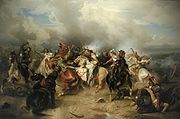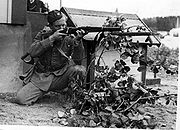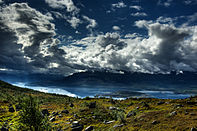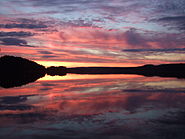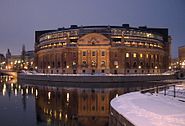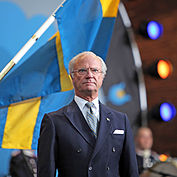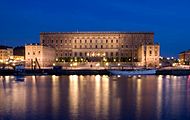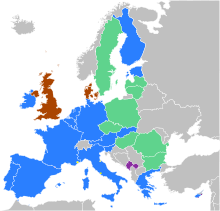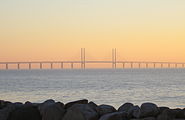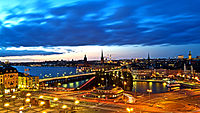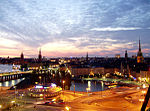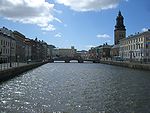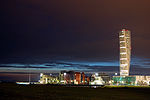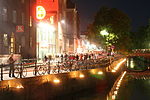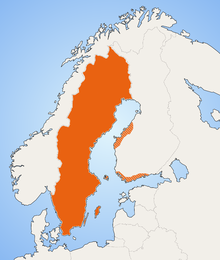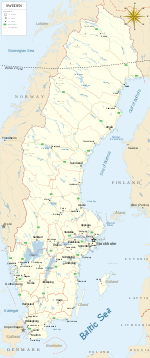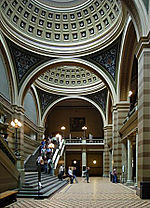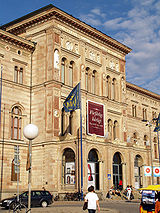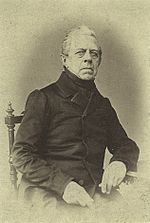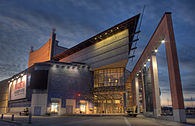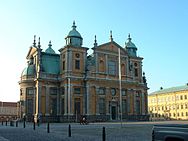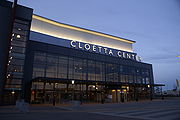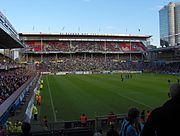- Sweden
-
Kingdom of Sweden Konungariket Sverige

Flag Coat of arms Motto: (Royal) "För Sverige i tiden"[a]
"For Sweden – With the Times"Anthem: Du gamla, Du fria[b]
Thou ancient, thou free
Royal anthem: Kungssången
The Song of the KingLocation of Sweden (dark green)– in Europe (green & dark grey)
– in the European Union (green) — [Legend]Capital
(and largest city)Stockholm
59°21′N 18°4′E / 59.35°N 18.067°EOfficial language(s) Swedish[c] Ethnic groups 90.8% Swedes[1][d]
~3% Finns[2]
~6,2% other (2011)[3][4]Demonym Swedish or Swedes Government Unitary parliamentary democracy and constitutional monarchy - Monarch King Carl XVI Gustaf - Prime Minister Fredrik Reinfeldt (M) - Speaker of
the RiksdagPer Westerberg (M) Legislature Riksdag Consolidation Area - Total 449,964 km2 (57th)
173,745 sq mi- Water (%) 8.7 Population - 2011 census 9,415,295[5] - Density 20.6/km2 (192nd)
53.8/sq miGDP (PPP) 2010 estimate - Total $337.893 billion[6] - Per capita $36,502[6] GDP (nominal) 2010 estimate - Total $443.718 billion[6] - Per capita $47,934[6] Gini (2005) 23 (low) HDI (2010)  0.885[7] (very high) (9th)
0.885[7] (very high) (9th)Currency Swedish krona ( SEK)Time zone CET (UTC+1) - Summer (DST) CEST (UTC+2) Date formats yyyy-mm-dd Drives on the right[e] ISO 3166 code SE Internet TLD .se[f] Calling code 46 a. ^ För Sverige – I tiden has been adopted by Carl XVI Gustaf as his personal motto.
b. ^ Du gamla, Du fria has never been officially adopted as national anthem, but is so by convention.
f. ^ The .eu domain is also used, as it is shared with other European Union member states. The .nu domain is another commonly used top-level domain ("nu" means "now" in Swedish).
c. ^ Since 1 July 2009.[8][9] Five other languages are officially recognized as minority languages.[10] They are: Finnish, Meänkieli, Romani, Sami and Yiddish. The Swedish Sign Language also has a special status.
d. ^ As of 2008, 18% of the population had foreign origins (13% if excluding Finns and 9% if also excluding other Scandinavians), with 14% foreign-born and another 4% born in Sweden of two foreign-born parents.[11]
e. ^ Since 3 September 1967.Sweden (
 i/ˈswiːdən/ swee-dən; Swedish: Sverige [ˈsværjɛ] (
i/ˈswiːdən/ swee-dən; Swedish: Sverige [ˈsværjɛ] ( listen)), officially the Kingdom of Sweden (Swedish:
listen)), officially the Kingdom of Sweden (Swedish:  Konungariket Sverige (help·info)), is a Nordic country on the Scandinavian Peninsula in Northern Europe. Sweden borders with Norway and Finland and is connected to Denmark by a bridge-tunnel across the Öresund.
Konungariket Sverige (help·info)), is a Nordic country on the Scandinavian Peninsula in Northern Europe. Sweden borders with Norway and Finland and is connected to Denmark by a bridge-tunnel across the Öresund.At 450,295 square kilometres (173,860 sq mi), Sweden is the third largest country in the European Union by area, with a total population of about 9.4 million.[5] Sweden has a low population density of 21 inhabitants per square kilometre (54 /sq mi) with the population mostly concentrated to the southern half of the country. About 85% of the population live in urban areas.[12] Sweden's capital is Stockholm, which is also the largest city.
Sweden emerged as an independent and unified country during the Middle Ages. In the 17th century, the country expanded its territories to form the Swedish Empire. The empire grew to be one of the great powers of Europe in the 17th and early 18th century. Most of the conquered territories outside the Scandinavian Peninsula were lost during the 18th and 19th centuries. The eastern half of Sweden, present-day Finland, was lost to Russia in 1809. The last war in which Sweden was directly involved was in 1814, when Sweden by military means forced Norway into a personal union. Since then, Sweden has been at peace, adopting a non-aligned foreign policy in peacetime and neutrality in wartime.[13]
Today, Sweden is a constitutional monarchy with a parliamentary democracy of government and a highly developed economy. In 2010, it ranked fourth in the world in The Economist's Democracy Index and ninth in the United Nations' Human Development Index. In 2010, the World Economic Forum ranked Sweden as the second most competitive country in the world, after Switzerland.[14] Sweden has been a member of the European Union since 1 January 1995 and is a member of the OECD.
Contents
Etymology
The modern name Sweden is derived through back-formation from Old English Swēoþēod, which meant "people of the Swedes" (Old Norse Svíþjóð, Latin Suetidi). This word is derived from Sweon/Sweonas (Old Norse Sviar, Latin Suiones). The Swedish name Sverige (a conjunction of the words Svea and Rike, first recorded as Swēorice in Beowulf, with the consonant 'k' softened to 'g'[15] – compare "rige" in modern Danish) literally means "Kingdom of the Swedes", excluding the Geats in Götaland.
Variations of the name Sweden are used in most languages, with the exception of Danish and Norwegian using Sverige, Icelandic Svíþjóð, and the more notable exception of some Finno-Ugric languages where Ruotsi (Finnish) and Rootsi (Estonian) are used, names commonly considered etymologically related to the English name for Russia, referring to the people, Rus', originally from the coastal areas of Roslagen, Uppland.
The etymology of Swedes, and thus Sweden, is generally not agreed upon but may derive from Proto-Germanic Swihoniz meaning "one's own",[16] referring to one's own Germanic tribe.
History
Prehistory
Sweden's prehistory begins in the Allerød warm period c. 12,000 BC with Late Palaeolithic reindeer-hunting camps of the Bromme culture at the edge of the ice in what is now the country's southernmost province. This period was characterized by small bands of hunter-gatherer-fishers using flint technology.
Sweden enters proto-history with the Germania of Tacitus in AD 98. In Germania 44, 45 he mentions the Swedes (Suiones) as a powerful tribe (distinguished not merely for their arms and men, but for their powerful fleets) with ships that had a prow in both ends (longships). Which kings (kuningaz) ruled these Suiones is unknown, but Norse mythology presents a long line of legendary and semi-legendary kings going back to the last centuries BC. As for literacy in Sweden itself, the runic script was in use among the south Scandinavian elite by at least the 2nd century AD, but all that has come down to the present from the Roman Period is curt inscriptions on artefacts, mainly of male names, demonstrating that the people of south Scandinavia spoke Proto-Norse at the time, a language ancestral to Swedish and other North Germanic languages.
In the 6th century Jordanes named two tribes he calls the Suehans and the Suetidi who lived in Scandza. These two names are both considered to refer to the same tribe. The Suehans, he says, has very fine horses just as the "Thyringi" tribe (alia vero gens ibi moratur Suehans, quae velud Thyringi equis utuntur eximiis). Snorri Sturluson wrote that the contemporary Swedish king Adils (Eadgils) had the finest horses of his days. The Suehans were the suppliers of black fox skins for the Roman market. Then Jordanes names the Suetidi which is considered to be the Latin form of Svitjod. He writes that the Suetidi are the tallest of men together with the Dani who were of the same stock. Later he mentions other Scandinavian tribes for being of the same height.
Originating in semi-legendary Scandza, believed to be somewhere in modern Götaland, Sweden, a Gothic population had crossed the Baltic Sea before the 2nd century AD, reaching Scythia at the coast of the Black Sea in modern Ukraine where Goths left their archaeological traces in the Chernyakhov culture. In the 5th and 6th centuries, they became divided as the Visigoths and the Ostrogoths, and established powerful successor-states of the Roman Empire in the Iberian peninsula and Italy.[17] Crimean Gothic communities appear to have survived intact in Crimea until the late 18th century.[18]
Viking and Middle Ages
The Swedish Viking Age lasted roughly between the 8th and 11th centuries. It is believed that Swedish Vikings and Gutar mainly travelled east and south, going to Finland, the Baltic countries, Russia, Belarus, Ukraine the Black Sea and further as far as Baghdad. Their routes passed through the Dnieper down south to Constantinople, on which they did numerous raids. The Byzantine Emperor Theophilos noticed their great skills in war and invited them to serve as his personal bodyguard, known as the varangian guard. The Swedish Vikings, called "Rus" are also believed to be the founding fathers of Kievan Rus. The Arabic traveller "Ibn Fadlan" described these Vikings as following:
I have seen the Rus as they came on their merchant journeys and encamped by the Itil. I have never seen more perfect physical specimens, tall as date palms, blond and ruddy; they wear neither tunics nor caftans, but the men wear a garment which covers one side of the body and leaves a hand free. Each man has an axe, a sword, and a knife, and keeps each by him at all times. The swords are broad and grooved, of Frankish sort.—[19]The adventures of these Swedish Vikings are commemorated on many runestones in Sweden, such as the Greece Runestones and the Varangian Runestones. There was also considerable participation in expeditions westwards, which are commemorated on stones such as the England Runestones. The last major Swedish Viking expedition appears to have been the ill-fated expedition of Ingvar the Far-Travelled to Serkland, the region south-east of the Caspian Sea. Its members are commemorated on the Ingvar Runestones, none of which mentions any survivor. What happened to the crew is unknown, but it is believed that they died of sickness.
- The Kingdom of Sweden
It is not known when and how the kingdom of Sweden was born, but the list of Swedish monarchs is drawn from the first kings known to have ruled both Svealand (Sweden) and Götaland (Gothia) as one province, beginning with Erik the Victorious. Sweden and Gothia were two separate nations long before that into antiquity. It is not known how long they existed, Beowulf described semi-legendary Swedish-Geatish wars in the 6th century.
- Cultural advances
During the early stages of the Scandinavian Viking Age, Ystad in Scania and Paviken on Gotland, in present-day Sweden, were flourishing trade centres. Remains of what is believed to have been a large market have been found in Ystad dating from 600–700 AD.[20] In Paviken, an important centre of trade in the Baltic region during the 9th and 10th century, remains have been found of a large Viking Age harbour with shipbuilding yards and handicraft industries. Between 800 and 1000, trade brought an abundance of silver to Gotland, and according to some scholars, the Gotlanders of this era hoarded more silver than the rest of the population of Scandinavia combined.[20]
St. Ansgar is usually credited for introducing Christianity in 829, but the new religion did not begin to fully replace paganism until the 12th century. During the 11th century, Christianity became the most prevalent religion, and from 1050 Sweden is counted as a Christian nation. The period between 1100 and 1400 was characterized by internal power struggles and competition among the Nordic kingdoms. Swedish kings also began to expand the Swedish-controlled territory in Finland, creating conflicts with the Rus who no longer had any connection with Sweden.[21]
- Feudal institutions in Sweden
Except for the province of Skane, on the southernmost tip of Sweden which was under Danish control during this time, feudalism never developed in Sweden as it did in the rest of Europe.[22] Therefore, the peasantry remained largely a class of free farmers throughout most of Swedish history. Slavery (also called thralldom) was not common in Sweden,[23] and what slavery there was tended to be driven out of existence by the spread of Christianity, the difficulty in obtaining slaves from the lands east of the Baltic Sea, and by the development of cities before the 16th century[24] Indeed, both slavery and serfdom were abolished altogether by a decree of King Magnus Erickson in 1335. Former slaves tended to be absorbed into the peasantry and some became labourers in the towns. Still, Sweden remained a poor and economically backward country in which barter was the means of exchange. For instance, the farmers of the province of Dalsland would transport their butter to the mining districts of Sweden and exchange it there for iron, which they would then take down to the coast and trade the iron for fish they needed for food while the iron would be shipped abroad.[25]
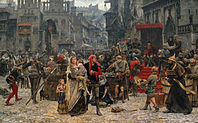 Valdemar IV takes control over Swedish Gotland. The final fight outside the walls of Visby ended with a total massacre of 1,800 Gotlanders.
Valdemar IV takes control over Swedish Gotland. The final fight outside the walls of Visby ended with a total massacre of 1,800 Gotlanders.
- The Plague in Sweden
In the 14th century, Sweden was struck by the Black Death. The population of Sweden was decimated.[26] During this period the Swedish cities also began to acquire greater rights and were strongly influenced by German merchants of the Hanseatic League, active especially at Visby. In 1319, Sweden and Norway were united under King Magnus Eriksson, and in 1397 Queen Margaret I of Denmark effected the personal union of Sweden, Norway, and Denmark through the Kalmar Union. However, Margaret's successors, whose rule was also centred in Denmark, were unable to control the Swedish nobility.
- Minors and Regents
A large number of children inherited the Swedish crown over the course of the kingdom's existence, consequently — real power was held for long periods by regents (notably those of the Sture family) chosen by the Swedish parliament. King Christian II of Denmark, who asserted his claim to Sweden by force of arms, ordered a massacre in 1520 of Swedish nobles at Stockholm. This came to be known as the "Stockholm blood bath" and stirred the Swedish nobility to new resistance and, on 6 June (now Sweden's national holiday) in 1523, they made Gustav Vasa their king.[27] This is sometimes considered as the foundation of modern Sweden. Shortly afterwards he rejected Catholicism and led Sweden into the Protestant Reformation. Economically, Gustav Vasa broke the monopoly of the Hanseatic League over Swedish Baltic Sea trade.[28]
The Hanseatic League had been officially formed at Lübeck on the sea coast of Northern Germany in 1356. The Hanseatic League sought civil and commercial privileges from the princes and royalty of the countries and cities along the coasts of the Baltic Sea.[29] In exchange they offered a certain amount of protection. Having their own navy the Hansa were able to sweep the Baltic Sea free of pirates.[30] The privileges obtained by the Hansa included assurances that only Hansa citizens would be allowed to trade from the ports where they were located. They also sought agreement to be free of all customs and taxes. With these concessions, Lübeck merchants flocked to Stockholm, Sweden and soon came to dominate the economic life of that city and made the port city of Stockholm into the leading commercial and industrial city of Sweden.[31] Under the Hanseatic trade 2/3rds of Stockholm's imports consisted of textiles and 1/3 of salt. Exports from Sweden consisted of iron and copper.[32]
However, the Swedes began to resent the monopoly trading position of the Hansa (mostly German citizens) and to resent the income they felt they lost to the Hansa. Consequently, when Gustav Vasa or Gustav I broke the monopoly power of the Hanseatic League he was regarded as a hero to the Swedish people. History now views Gustav I as the father of the modern Swedish nation. The foundations laid by Gustav would take time to develop. Furthermore, when Sweden did develop, freed itself from the Hanseatic League and entered its golden era, the fact the peasantry had traditionally been free meant that more of the economic benefits flowed back to them rather than going to a feudal landowning class.[33] This was not the case in other countries of Europe like Poland were the peasantry was still bound by serfdom and a strong feudalistic land owning system.
Swedish Empire
See also: History of Sweden (1611–1648), Swedish Empire, Swedish overseas colonies, Sweden and the Great Northern War, Absolute Monarchy in Sweden, Sweden-Finland, and Union between Sweden and NorwayDuring the 17th century Sweden emerged as a European great power. Before the emergence of the Swedish Empire, Sweden was a very poor and scarcely populated country on the fringe of European civilization, with no significant power or reputation. Sweden rose to prominence on a continental scale during the tenure of king Gustavus Adolphus, seizing territories from Russia and Poland–Lithuania in multiple conflicts, including the Thirty Years' War.
During the Thirty Years' War, Sweden conquered approximately half of the Holy Roman states. Gustav Adolphus planned to become the new Holy Roman Emperor, ruling over a united Scandinavia and the Holy Roman states, but he died at the Battle of Lützen in 1632. After the Battle of Nördlingen, Sweden's only significant military defeat of the war, pro-Swedish sentiment among the German states faded. These German provinces excluded themselves from Swedish power one by one, leaving Sweden with only a few northern German territories: Swedish Pomerania, Bremen-Verden and Wismar. The Swedish armies may have destroyed up to 2,000 castles, 18,000 villages and 1,500 towns in Germany, one-third of all German towns.[34]
In the middle of the 17th century Sweden was the third largest country in Europe by land area, only surpassed by Russia and Spain. Sweden reached its largest territorial extent under the rule of Charles X after the treaty of Roskilde in 1658.[35][36] The foundation of Sweden's success during this period is credited to Gustav I's major changes on the Swedish economy in the 16th century, and his introduction of Protestantism.[37] In the 17th century, Sweden was engaged in many wars, for example with the Polish-Lithuanian Commonwealth with both sides competing for territories of today's Baltic states, with the disastrous Battle of Kircholm being one of the highlights.[38] One-third of the Finnish population died in the devastating famine that struck the country in 1696.[39] Famine also hit Sweden,[40] killing roughly 10% of Sweden's population.[41]
The Swedes conducted a series of invasions into the Polish-Lithuanian Commonwealth, known as the Deluge. After more than half a century of almost constant warfare, the Swedish economy had deteriorated. It became the lifetime task of Charles' son, Charles XI, to rebuild the economy and refit the army. His legacy to his son, the coming ruler of Sweden Charles XII, was one of the finest arsenals in the world, a large standing army and a great fleet. Sweden's largest threat at this time, Russia, had a larger army but was far behind in both equipment and training.
After the Battle of Narva in 1700, one of the first battles of the Great Northern War, the Russian army was so severely decimated that Sweden had an open chance to invade Russia. However, Charles did not pursue the Russian army, instead turning against Poland-Lithuania and defeating the Polish king Augustus II and his Saxon allies at the Battle of Kliszow in 1702. This gave Russia time to rebuild and modernize its army.
After the success of invading Poland, Charles decided to make an invasion attempt of Russia which ended in a decisive Russian victory at the Battle of Poltava in 1709. After a long march exposed to Cossack raids, Russian Tsar Peter the Great's scorched-earth techniques and the cold Russian climate, the Swedes stood weakened with a shattered morale and enormously outnumbered against the Russian army at Poltava. The defeat meant the beginning of the end for the Swedish Empire.
 The Battle of Poltava in 1709. In the years following Poltava, Russia occupied all the Swedish annexations on the Baltic coast and even Finland.
The Battle of Poltava in 1709. In the years following Poltava, Russia occupied all the Swedish annexations on the Baltic coast and even Finland.
Charles XII attempted to invade Norway 1716; however, he was shot dead at Fredriksten fortress in 1718. The Swedes were not militarily defeated at Fredriksten, but the whole structure and organization of the Norwegian campaign fell apart with the king's death, and the army withdrew.
Forced to cede large areas of land in the Treaty of Nystad in 1721, Sweden also lost its place as an empire and as the dominant state on the Baltic Sea. With Sweden's lost influence, Russia emerged as an empire and became one of Europe's dominant nations. As the war finally ended in 1721, Sweden had lost an estimated 200,000 men, 150,000 of those from the area of present-day Sweden and 50,000 from the Finnish part of Sweden.[42]
In the 18th century, Sweden did not have enough resources to maintain its territories outside Scandinavia, and most of them were lost, culminating with the 1809 loss of eastern Sweden to Russia which became the highly autonomous Grand Principality of Finland in Imperial Russia.
In interest of re-establishing Swedish dominance in the Baltic Sea, Sweden allied itself against its traditional ally and benefactor, France, in the Napoleonic Wars. Sweden's role in the Battle of Leipzig gave it the authority to force Denmark-Norway, an ally of France, to cede Norway to the King of Sweden on 14 January 1814 in exchange for northern German provinces, at the Treaty of Kiel. The Norwegian attempts to keep their status as a sovereign state were rejected by the Swedish king, Charles XIII. He launched a military campaign against Norway on 27 July 1814, ending in the Convention of Moss, which forced Norway into a personal union with Sweden under the Swedish crown, which lasted until 1905. The 1814 campaign was the last war in which Sweden participated as a combatant. Swedish troops partake in peace-keeping missions and currently have forces deployed in Afghanistan and Kosovo.
Modern history
There was a significant population increase during the 18th and 19th centuries, which the writer Esaias Tegnér in 1833 attributed to "the peace, the (smallpox) vaccine, and the potatoes".[43] Between 1750 and 1850, the population in Sweden doubled. According to some scholars, mass emigration to America became the only way to prevent famine and rebellion; over 1% of the population emigrated annually during the 1880s.[44] Nevertheless, Sweden remained poor, retaining a nearly entirely agricultural economy even as Denmark and Western European countries began to industrialize.[44][45]
Many looked towards America for a better life during this time. It is believed that between 1850 and 1910 more than one million Swedes moved to the United States.[46] In the early 20th century, more Swedes lived in Chicago than in Gothenburg (Sweden's second largest city).[47] Most Swedish immigrants moved to the Midwestern United States, with a large population in Minnesota, with a few others moving to other parts of the United States and Canada.
Despite the slow rate of industrialization into the 19th century, many important changes were taking place in the agrarian economy because of innovations and the large population growth.[48] These innovations included government-sponsored programs of enclosure, aggressive exploitation of agricultural lands, and the introduction of new crops such as the potato.[48] Because the Swedish peasantry had never been enserfed as elsewhere in Europe,[49] the Swedish farming culture began to take on a critical role in the Swedish political process, which has continued through modern times with modern Agrarian party (now called the Centre Party).[50] Between 1870 and 1914, Sweden began developing the industrialized economy that exists today.[51]
Strong grassroots movements sprung up in Sweden during the latter half of the 19th century (trade unions, temperance groups, and independent religious groups), creating a strong foundation of democratic principles. In 1889 The Swedish Social Democratic Party was founded. These movements precipitated Sweden's migration into a modern parliamentary democracy, achieved by the time of World War I. As the Industrial Revolution progressed during the 20th century, people gradually began moving into cities to work in factories and became involved in socialist unions. A communist revolution was avoided in 1917, following the re-introduction of parliamentarism, and the country was democratized.
World Wars
Sweden remained officially neutral during World War I and World War II, although its neutrality during World War II has been disputed.[52][53] Sweden was under German influence for much of the war, as ties to the rest of the world were cut off through blockades.[52] The Swedish government felt that it was in no position to openly contest Germany,[54] and therefore made some concessions.[55] Sweden also supplied steel and machined parts to Germany throughout the war. However, Sweden supported Norwegian resistance, and in 1943 helped rescue Danish Jews from deportation to concentration camps. Sweden also supported Finland in the Winter War and the Continuation War with volunteers and materiel.
Toward the end of the war, Sweden began to play a role in humanitarian efforts and many refugees, among them many Jews from Nazi-occupied Europe, were saved partly because of the Swedish involvement in rescue missions at the internment camps and partly because Sweden served as a haven for refugees, primarily from the Nordic countries and the Baltic states.[54] The Swedish diplomat Raoul Wallenberg and his colleagues may have saved up to 100,000 Hungarian Jews.[56] Nevertheless, internal and external critics have argued that Sweden could have done more to resist the Nazi war effort, even if risking occupation.[54]
Post-war era
Sweden was officially a neutral country and remained outside NATO or Warsaw pact membership during the cold war, but privately Sweden's leadership had strong ties with the United States and other western governments.
Following the war, Sweden took advantage of an intact industrial base, social stability and its natural resources to expand its industry to supply the rebuilding of Europe.[57] Sweden was part of the Marshall Plan and participated in the Organization of Economic Co-operation and Development (OECD). During most of the post-war era, the country was governed by the Swedish Social Democratic Party largely in cooperation with trade unions and industry. The government actively pursued an internationally competitive manufacturing sector of primarily large corporations.[58]
Sweden, like countries around the globe, entered a period of economic decline and upheaval, following the oil embargoes of 1973–74 and 1978–79.[59] In the 1980s pillars of Swedish industry were massively restructured. Shipbuilding was discontinued, wood pulp was integrated into modernized paper production, the steel industry was concentrated and specialized, and mechanical engineering was robotized.[60]
Between 1970 and 1990 the overall tax burden rose by over 10%, and the growth was low compared to other countries in Western Europe. The marginal income tax for workers reached over 80%.[citation needed] Eventually government spent over half of the country's gross domestic product. Sweden GDP per capita ranking declined during this time.[58]
Recent history
A bursting real estate bubble caused by inadequate controls on lending combined with an international recession and a policy switch from anti-unemployment policies to anti-inflationary policies resulted in a fiscal crisis in the early 1990s.[61] Sweden's GDP declined by around 5%. In 1992, there was a run on the currency, with the central bank briefly jacking up interest to 500%.[62][63]
The response of the government was to cut spending and institute a multitude of reforms to improve Sweden's competitiveness, among them reducing the welfare state and privatising public services and goods. Much of the political establishment promoted EU membership, and the Swedish referendum passed with 52% in favour of joining the EU on 13 November 1994. Sweden joined the European Union on 1 January 1995.
Sweden remains non-aligned militarily, although it participates in some joint military exercises with NATO and some other countries, in addition to extensive cooperation with other European countries in the area of defence technology and defence industry. Among others, Swedish companies export weapons that are used by the American military in Iraq.[64] Sweden also has a long history of participating in international military operations, including most recently, Afghanistan, where Swedish troops are under NATO command, and in EU sponsored peacekeeping operations in UN protectorate Kosovo, Bosnia and Herzegovina, and Cyprus. Sweden held the chair of the European Union from 1 July to 31 December 2009.
Geography
Situated in Northern Europe, Sweden lies west of the Baltic Sea and Gulf of Bothnia, providing a long coastline, and forms the eastern part of the Scandinavian Peninsula. To the west is the Scandinavian mountain chain (Skanderna), a range that separates Sweden from Norway. Finland is located to its northeast. It has maritime borders with Denmark, Germany, Poland, Russia, Lithuania, Latvia and Estonia, and it is also linked to Denmark (southwest) by the Öresund Bridge.
Sweden lies between latitudes 55° and 70° N, and mostly between longitudes 11° and 25° E (part of Stora Drammen island is just west of 11°).
At 449,964 km2 (173,732 sq mi), Sweden is the 55th largest country in the world,[65] the 4th largest in Europe (excluding European Russia), and the largest in Northern Europe. The lowest elevation in Sweden is in the bay of Lake Hammarsjön, near Kristianstad at −2.41 m (−7.91 ft) below sea level. The highest point is Kebnekaise at 2,111 m (6,926 ft) above sea level.
Sweden has 25 provinces or landskap (landscapes), based on culture, geography and history. While these provinces serve no political or administrative purpose, they play an important role for people's self-identification. The provinces are usually grouped together in three large lands, parts, the northern Norrland, the central Svealand and southern Götaland. The sparsely populated Norrland encompasses almost 60% of the country.
About 15% of Sweden lies north of the Arctic Circle. Southern Sweden is predominantly agricultural, with increasing forest coverage northward. Around 65% of Sweden's total land area is covered with forests. The highest population density is in the Öresund Region in southern Sweden, along the western coast up to central Bohuslän, and in the valley of lake Mälaren and Stockholm. Gotland and Öland are Sweden's largest islands; Vänern and Vättern are its largest lakes. Vänern is the third largest in Europe, after Lake Ladoga and Lake Onega in Russia.
Climate
Most of Sweden has a temperate climate, despite its northern latitude, with four distinct seasons and mild temperatures throughout the year. The country can be divided into three types of climate; the southernmost part has an oceanic climate, the central part has a humid continental climate and the northernmost part has a subarctic climate. However, Sweden is much warmer and drier than other places at a similar latitude, and even somewhat farther south, mainly because of the Gulf Stream.[66][67] For example, central and southern Sweden has much warmer winters than many parts of Russia, Canada, and the northern United States.[68] Because of its high latitude, the length of daylight varies greatly. North of the Arctic Circle, the sun never sets for part of each summer, and it never rises for part of each winter. In the capital, Stockholm, daylight lasts for more than 18 hours in late June but only around 6 hours in late December. Sweden receives between 1,100 to 1,900 hours of sunshine annually.[69][70]
Temperatures vary greatly from north to south. Southern and central parts of the country have warm summers and cold winters, with average high temperatures of 20 to 25 °C (68 to 77 °F)[71] and lows of 12 to 15 °C (54 to 59 °F)[72] in the summer, and average temperatures of -4 to 2 °C (25 to 36 °F) in the winter,[73] while the northern part of the country has shorter, cooler summers and longer, colder and snowier winters, with temperatures that often drop below freezing from September through May.[74][75] The highest temperature ever recorded in Sweden was 38 °C (100 °F) in Målilla in 1947, while the coldest temperature ever recorded was −52.6 °C (−62.7 °F) in Vuoggatjålme in 1966.[76][77]
On average, most of Sweden receives between 500 and 800 mm (20 and 31 in) of precipitation each year, making it considerably drier than the global average. The southwestern part of the country receives more precipitation, between 1000 and 1200 mm (39 and 47 in), and some mountain areas in the north are estimated to receive up to 2000 mm (79 in). Despite northerly locations, southern and central Sweden may have almost no snow in some winters.[78][79]
Average high and low temperatures in various cities in Sweden (°C)[80] City Jan Feb Mar Apr May Jun Jul Aug Sep Oct Nov Dec Kiruna −10/−16 −8/−15 −4/−13 2/−7 8/0 14/6 17/8 14/6 9/2 1/−4 −5/−10 −8/−15 Östersund −5/−10 −3/−9 0/−6 5/−2 12/3 16/8 18/10 17/10 12/6 6/2 0/−3 −3/−8 Stockholm 1/−2 1/−3 4/−2 11/3 16/8 20/12 23/15 22/14 17/10 10/6 5/2 1/−1 Gothenburg (Göteborg) 2/−1 4/−1 6/0 11/3 16/8 19/12 22/14 22/14 18/10 12/6 7/3 3/−1 Visby 1/−2 1/−3 3/−2 9/1 14/6 18/10 21/13 20/13 16/9 10/6 5/2 2/0 Malmö 3/−1 3/−1 6/0 12/3 17/8 19/11 22/13 22/14 18/10 12/6 8/4 4/1 Politics
Sweden is a constitutional monarchy, in which King Carl XVI Gustaf is head of state, but royal power has long been limited to official and ceremonial functions.[81] The Economist Intelligence Unit, while acknowledging that democracy is difficult to measure, listed Sweden in fourth place in 2010 in its index of democracy assessing 167 countries.
The nation's legislative body is the Riksdag (Swedish Parliament), with 349 members, which chooses the Prime Minister. Parliamentary elections are held every four years, on the third Sunday of September.
Administrative divisions
Sweden is a unitary state, currently divided into twenty-one counties (län): Stockholm, Uppsala, Södermanland, Östergötland, Jönköping, Kronoberg, Kalmar, Gotland, Blekinge, Skåne, Halland, Västra Götaland, Värmland, Örebro, Västmanland, Dalarna, Gävleborg, Västernorrland, Jämtland, Västerbotten and Norrbotten.
Each county has a County Administrative Board or länsstyrelse, which is a Government appointed board. It is led by a Governor or Landshövding appointed for a term of six years and the list of succession, in most cases, stretches back to 1634 when the counties were created by the Swedish Lord High Chancellor Axel Oxenstierna. The main responsibility of the County Administrative Board is to coordinate the development of the county in line with goals set in national politics. In each county there is also a County Council or landsting which is a policy-making assembly elected by the residents of the county.
Each county further divides into a number of municipalities or kommuner, with a total of 290 municipalities in 2004. Municipal government in Sweden is similar to city commission government and cabinet-style council government. A legislative municipal assembly (kommunfullmäktige) of between 31 and 101 members (always an uneven number) is elected from party-list proportional representation at municipal elections, held every four years in conjunction with the national parliamentary elections.
The municipalities are divided into a total of 2,512 parishes, or församlingar. These have traditionally been a subdivision of the Church of Sweden but still have importance as districts for census and elections. There are older historical divisions, primarily the twenty-five provinces and three lands, which still retain cultural significance.
Political history
The actual age of the kingdom of Sweden is unknown.[82] It depends mostly on whether Sweden should be considered a nation when the Svear (Sweonas) ruled Svealand or if the emergence of the nation started with the Svear and the Götar (Geats) of Götaland being united under one ruler. In the first case, Sweden was first mentioned as having one single ruler in the year 98 by Tacitus, but it is almost impossible to know for how long it had been this way. However, historians usually start the line of Swedish monarchs from when Svealand and Götaland were ruled under the same king, namely Erik the Victorious (Geat) and his son Olof Skötkonung in the 10th century. These events are often described as the consolidation of Sweden, although substantial areas were conquered and incorporated later.
Earlier kings, for which no reliable historical sources exist, can be read about in mythical kings of Sweden and semi-legendary kings of Sweden. Many of these kings are only mentioned in various saga and blend with Norse mythology.
The title Sveriges och Götes Konung was last used for Gustaf I of Sweden, after which the title became "King of Sweden, of the Goths and of the Wends" (Sveriges, Götes och Vendes Konung) in official documentation. Up until the beginning of the 1920s, all laws in Sweden were introduced with the words, "We, the king of Sweden, of the Goths and Wends". This title was used up until 1973.[83] The present King of Sweden, Carl XVI Gustaf, was the first monarch officially proclaimed "King of Sweden" (Sveriges Konung) with no additional peoples mentioned in his title.
The term Riksdag was used for the first time in the 1540s, although the first meeting where representatives of different social groups were called to discuss and determine affairs affecting the country as a whole took place as early as 1435, in the town of Arboga.[84] During the assemblies of 1527 and 1544, under King Gustav Vasa, representatives of all four estates of the realm (clergy, nobility, townsmen and peasants) were called on to participate for the first time.[84] The monarchy became hereditary in 1544.
Executive power was historically shared between the King and a noble Privy Council until 1680, followed by the King's autocratic rule initiated by the common estates of the Parliament. As a reaction to the failed Great Northern War, a parliamentary system was introduced in 1719, followed by three different flavours of constitutional monarchy in 1772, 1789 and 1809, the latter granting several civil liberties. The monarch remains as the formal, but merely symbolic, head of state with ceremonial duties.
The Riksdag of the Estates consisted of two chambers. In 1866 Sweden became a constitutional monarchy with a bicameral parliament, with the First Chamber indirectly elected by local governments, and the Second Chamber directly elected in national elections every four years. In 1971 the Riksdag became unicameral. Legislative power was (symbolically) shared between king and parliament until 1975. Swedish taxation is controlled by the Riksdag (parliament).
Sweden has a history of strong political involvement by ordinary people through its "popular movements" (Folkrörelser), the most notable being trade unions, the independent Christian movement, the temperance movement, the women's movement and more recently the sports[clarification needed] and intellectual property pirate movements.
Sweden is currently leading the EU in statistics measuring equality in the political system and equality in the education system.[85] The Global Gender Gap Report 2006 ranked Sweden as the number one country in terms of gender equality.[86]
Political system
Constitutionally, the 349-member Riksdag (Parliament) holds supreme authority in modern Sweden. The Riksdag is responsible for choosing the prime minister, who then appoints the government department heads (cabinet ministers). Legislative power is only exercised by the Riksdag. Executive power is exercised by the prime minister and the cabinet, while the judiciary is independent. Sweden lacks compulsory judicial review, although the non-compulsory review carried out by lagrådet (Law Council) is mostly respected in technical matters but less so in controversial political matters. Acts of the parliament and government decrees can be made inapplicable at every level if they are manifestly against constitutional laws. However, because of the restrictions in this form of judicial review and a weak judiciary, this has had little practical consequence.
Legislation may be initiated by the cabinet or by members of Parliament. Members are elected on the basis of proportional representation to a four-year term. The Constitution of Sweden can be altered by the Riksdag, which requires a simple but absolute majority with two separate votes, separated by general elections in between. Sweden has three other constitutional laws: the Act of Royal Succession, the Freedom of Press Act and the Fundamental Law on Freedom of Expression.
The Swedish Social Democratic Party has played a leading political role since 1917, after Reformists had confirmed their strength and the revolutionaries left the party. After 1932, cabinets have been dominated by the Social Democrats. Only five general elections (1976, 1979, 1991, 2006 and 2010) have given the centre-right bloc enough seats in Parliament to form a government. However, due to poor economic performance since the beginning of the 1970s, and especially since the fiscal crisis of the early 1990s, Sweden's political system has become less one-sided, and more like other European countries.
In the 2006 general election the Moderate Party, allied with the Centre Party, Liberal People's Party, and the Christian Democrats formed the centre-right Alliance for Sweden and won a majority of the votes. Together they formed a majority government under the leadership of the Moderate party's leader Fredrik Reinfeldt. In the September 2010 election the Alliance contended against a unified left block consisting of the Social Democrats, the Greens and the Left Party. It also saw the first election of the conservative Sweden Democrats into the Riksdag.[87]
Following is the current party lineup in the Swedish parliament, as of October 2011[update], organized by voting blocks:[88]
English name Swedish name Abbr. Seats Moderate Party Moderata samlingspartiet (M) 107 Liberal People's Party Folkpartiet liberalerna (FP) 24 Centre Party Centerpartiet (C) 23 Christian Democrats Kristdemokraterna (KD) 19 Total centre-right block 173 Social Democrats Socialdemokraterna (S) 112 The Greens Miljöpartiet (MP) 25 Left Party Vänsterpartiet (V) 19 Total centre-left block 156 Sweden Democrats Sverigedemokraterna (SD) 19 Former party members Politisk vilde 1 Total parliament 349 The Alliance won a plurality of 173 seats, but remained two seats short of a 175-seat majority. Nevertheless, neither the Alliance, nor the left block chose to form a coalition with the Sweden Democrats, and the Alliance is currently governing as a minority government.[89]
Election turnout in Sweden has always been high by international comparison, although it has declined in recent decades, and is currently around 80% (80.11 in 2002, and 81.99% in 2006). Swedish politicians enjoyed a high degree of confidence from the citizens in the 1960s, However, that confidence level has since declined steadily, and is now at a markedly lower level than in its Scandinavian neighbours.[90]
Some Swedish political figures have become known worldwide, among these are: Raoul Wallenberg, Folke Bernadotte, former Secretary General of the United Nations Dag Hammarskjöld, former Prime Minister Olof Palme, former Prime Minister and Foreign minister Carl Bildt, former President of the General Assembly of the United Nations Jan Eliasson, and former International Atomic Energy Agency Iraq inspector Hans Blix.
Law, law enforcement, and judicial system
Main article: Judicial system of SwedenThe Supreme Court of Sweden is the third and final instance in all civil and criminal cases in Sweden. Before a case can be decided by the Supreme Court, leave to appeal must be obtained, and with few exceptions, leave to appeal can be granted only when the case is of interest as a precedent. The Supreme Court consists of 16 Councillors of Justice or justitieråd which are appointed by the government, but the court as an institution is independent of the Riksdag, and the government is not able to interfere with the decisions of the court.
Law enforcement in Sweden is carried out by several government entities. The Swedish Police Service is a Government agency concerned with police matters. The National Task Force is a national SWAT unit within the National Criminal Investigation Department. Swedish Security Service's responsibilities are counter-espionage, anti-terrorist activities, protection of the constitution and protection of sensitive objects and people.
According to a victimization survey of 1,201 residents in 2005, Sweden has above average crime rates compared to other EU countries. Sweden has high or above average levels of assaults, sexual assaults, hate crimes, and consumer fraud. Sweden has low levels of burglary, car theft and drug problems. Bribe seeking is rare.[91]
Foreign relations
Throughout the 20th century, Swedish foreign policy was based on the principle of non-alignment in peacetime and neutrality in wartime. Sweden's government pursued an independent course of nonalignment in times of peace so that neutrality would be possible in the event of war.[57]
Sweden's doctrine of neutrality is often traced back to the 19th century as the country has not been in a state of war since the end of the Swedish campaign against Norway in 1814. During World War II Sweden joined neither the allied nor axis powers. This has sometimes been disputed since in effect Sweden allowed in select cases the Nazi regime to use its railroad system to transport troops and goods,[52][54] especially iron ore from mines in northern Sweden, which was vital to the German war machine.[54][92] However, Sweden also indirectly contributed to the defence of Finland in the Winter War, and permitted the training of Norwegian and Danish troops in Sweden after 1943.
During the early Cold War era, Sweden combined its policy of non-alignment and a low profile in international affairs with a security policy based on strong national defence.[93] The function of the Swedish military was to deter attack.[94] At the same time, the country maintained relatively close informal connections with the Western bloc, especially in the realm of intelligence exchange. In 1952, a Swedish DC-3 was shot down over the Baltic Sea by a Soviet MiG-15 jet fighter. Later investigations revealed that the plane was actually gathering information for NATO.[95] Another plane, a Catalina search and rescue plane, was sent out a few days later and shot down by the Soviets as well. Olof Palme, the former prime minister of Sweden, visited Cuba during the 1970s and showed his support for Cuba in his speech.
Beginning in the late 1960s, Sweden for a period attempted to play a more significant and independent role in international relations. This involved significant activity in international peace efforts, especially through the United Nations, and in support to the Third World. Since the assassination of Olof Palme in 1986 and the end of the Cold War, this has been significantly toned down, although Sweden remains comparatively active in peace keeping missions and maintains a generous foreign aid budget.
In 1981 a Soviet Whiskey class submarine ran aground close to the Swedish naval base at Karlskrona in the southern part of the country. It has never been clearly established whether the submarine ended up on the shoals through a navigational mistake or if it was a matter of espionage against Swedish military potential. The incident triggered a diplomatic crisis between Sweden and the Soviet Union.
Since 1995 Sweden has been a member of the European Union, and as a consequence of a new world security situation the country's foreign policy doctrine has been partly modified, with Sweden playing a more active role in European security co-operation.
Military
Försvarsmakten (Swedish Armed Forces) is a government agency reporting to the Swedish Ministry of Defence and responsible for the peacetime operation of the armed forces of Sweden. The primary task of the agency is to train and deploy peace support forces abroad, while maintaining the long-term ability to refocus on the defence of Sweden in the event of war. The armed forces are divided into Army, Air Force and Navy. The head of the armed forces is the Supreme Commander (Överbefälhavaren, ÖB), the most senior officer in the country. Up to 1974 the head of state (=the King) was pro forma Commander-in-Chief, but in reality it was clearly understood all through the 20th century that the Monarch would have no active role as a military leader.
When King Gustav V asserted his right to decide and bypass the government in military matters just before the First World War ("borggårdskrisen", the Castle Court Crisis) it was seen as a deliberate provocation against established terms of how the country would be ruled. The office of an appointed Supreme Commander was set up in 1939; before that date, from the late 19th century onwards, the leading men of the army and navy would report directly to the cabinet (and the king), and no fully unified command existed in the professional military sphere itself.
Until the end of the Cold War, nearly all males reaching the age of military service were conscripted. In recent years, the number of conscripted males has shrunk dramatically, while the number of female volunteers has increased slightly. Recruitment has generally shifted towards finding the most motivated recruits, rather than solely those otherwise most fit for service. All soldiers serving abroad must by law be volunteers. In 1975 the total number of conscripts was 45,000. By 2003 it was down to 15,000.
On 1 July 2010 Sweden stopped routine conscription, switching to an all volunteer force unless otherwise required for defence readiness.[96][97][98] The need to recruit only the soldiers later prepared to volunteer for international service will be emphasized. The total forces gathered would consist of about 60,000 men. This could be compared with the 80s before the fall of the Soviet Union, when Sweden could gather up to 1,000,000 men.
Swedish units have taken part in peacekeeping operations in the Democratic Republic of Congo, Cyprus, Bosnia and Herzegovina, Kosovo, Liberia, Lebanon, Afghanistan and Chad.
Currently, one of the most important tasks for the Swedish Armed Forces has been to form a Swedish-led EU Battle Group to which Norway, Finland, Ireland and Estonia will also contribute.[99] The Nordic Battle Group (NBG) had a 10-day deployment readiness during the first half of 2008 and, although Swedish-led, had its Operational Headquarters (OHQ) in Northwood, outside London.
Economy
Sweden is an export-oriented mixed economy featuring a modern distribution system, excellent internal and external communications, and a skilled labour force. Timber, hydropower and iron ore constitute the resource base of an economy heavily oriented toward foreign trade. Sweden's engineering sector accounts for 50% of output and exports. Telecommunications, the automotive industry and the pharmaceutical industries are also of great importance. Agriculture accounts for 2% of GDP and employment. Income is relatively flatly distributed, Sweden has the lowest Gini coefficient (0.23) of any country.
In terms of structure, the Swedish economy is characterised by a large, knowledge-intensive and export-oriented manufacturing sector, an increasing, but comparatively small, business service sector, and by international standards, a large public service sector. Large organisations both in manufacturing and services dominate the Swedish economy.[100]
The 20 largest (by turnover in 2007) companies registered in Sweden are Volvo, Ericsson, Vattenfall, Skanska, Sony Ericsson Mobile Communications AB, Svenska Cellulosa Aktiebolaget, Electrolux, Volvo Personvagnar, TeliaSonera, Sandvik, Scania, ICA, Hennes & Mauritz, IKEA, Nordea, Preem, Atlas Copco, Securitas, Nordstjernan and SKF.[101] Sweden's industry is overwhelmingly in private control; unlike some other industrialised Western countries, such as Austria and Italy, publicly owned enterprises have always been of minor importance.
Some 4.5 million residents are working, out of which around a third has tertiary education. GDP per hour worked is the world's 9th highest at 31 USD in 2006, compared to 22 USD in Spain and 35 USD in United States.[102] GDP per hour worked is growing 2½ per cent per year for the economy as a whole and the trade-terms-balanced productivity growth is 2%.[102] According to OECD, deregulation, globalisation, and technology sector growth have been key productivity drivers.[102] Sweden is a world leader in privatised pensions and pension funding problems are relatively small compared to many other Western European countries.[103]
The typical worker receives 40% of his income after the tax wedge. The slowly declining overall taxation, 51.1% of GDP in 2007, is still nearly double of that in the United States or Ireland. The share of employment financed via tax income amounts to a third of Swedish workforce, a substantially higher proportion than in most other countries. Overall, GDP growth has been fast since reforms in the early 1990s, especially in manufacturing.[104]
The World Economic Forum 2009–2010 competitiveness index ranks Sweden the 4th most competitive economy in the world.[105] In the World Economic Forum 2010–2011 Global Competitiveness Report, Sweden climbed two positions, and is now ranked 2nd in the world.[106] Sweden is ranked 6th in the IMD Competitiveness Yearbook 2009, scoring high in private sector efficiency.[107] According to the book, The Flight of the Creative Class, by the U.S. economist, Professor Richard Florida of the University of Toronto, Sweden is ranked as having the best creativity in Europe for business and is predicted to become a talent magnet for the world's most purposeful workers. The book compiled an index to measure the kind of creativity it claims is most useful to business—talent, technology and tolerance.[108]
Sweden maintains its own currency, the Swedish krona (SEK), a result of the Swedes having rejected the euro in a referendum. The Swedish Riksbank—founded in 1668 and thus making it the oldest central bank in the world—is currently focusing on price stability with an inflation target of 2%. According to the Economic Survey of Sweden 2007 by the OECD, the average inflation in Sweden has been one of the lowest among European countries since the mid-1990s, largely because of deregulation and quick utilisation of globalisation.[102]
The largest trade flows are with Germany, the United States, Norway, the United Kingdom, Denmark and Finland.
Energy
Sweden's energy market is largely privatized. The Nordic energy market is one of the first liberalized energy markets in Europe and it is traded in NASDAQ OMX Commodities Europe and Nord Pool Spot. In 2006, out of a total electricity production of 139 TWh, electricity from hydropower accounted for 61 TWh (44%), and nuclear power delivered 65 TWh (47%). At the same time, the use of biofuels, peat etc. produced 13 TWh (9%) of electricity, while wind power produced 1 TWh (1%). Sweden was a net importer of electricity by a margin of 6 TWh.[109] Biomass is mainly used to produce heat for district heating and central heating and industry processes.
The 1973 oil crisis strengthened Sweden's commitment to decrease dependence on imported fossil fuels. Since then, electricity has been generated mostly from hydropower and nuclear power. The use of nuclear power has been limited, however. Among other things, the accident of Three Mile Island Nuclear Generating Station (United States) prompted the Swedish parliament to ban new nuclear plants. In March 2005, an opinion poll showed that 83% supported maintaining or increasing nuclear power.[110] Politicians have made announcements about oil phase-out in Sweden, decrease of nuclear power, and multi-billion dollar investments in renewable energy and energy efficiency.[111][112] The country has for many years pursued a strategy of indirect taxation as an instrument of environmental policy, including energy taxes in general and carbon dioxide taxes in particular.[111]
Transport
Sweden has 162,707 km (101,101 mi) of paved road and 1,428 km (887 mi) of expressways. Motorways run through Sweden, Denmark and over the Öresund Bridge to Stockholm, Gothenburg, Uppsala and Uddevalla. The system of motorways is still under construction and a new motorway from Uppsala to Gävle was finished on 17 October 2007. Sweden had left-hand traffic (Vänstertrafik in Swedish) from approximately 1736 and continued to do so well into the 20th century. Voters rejected right-hand traffic in 1955, but after the Riksdag passed legislation in 1963 changeover took place in 1967, known in Swedish as Dagen H.
The Stockholm metro is the only subway system in Sweden and serves the city of Stockholm, 100 metro stations are in use.
The rail transport market is privatized, but while there are many privately owned enterprises, many operators are still owned by state. The counties have financing, ticket and marketing responsibility for local trains. For other trains the operators handle tickets and marketing themselves. Operators include SJ, Veolia Transport, DSB, Green Cargo, Tågkompaniet and Inlandsbanan. Most of the railways are owned and operated by Trafikverket.
The largest airports include Stockholm-Arlanda Airport (16.1 million passengers in 2009) 40 km (25 mi) north of Stockholm, Gothenburg-Landvetter Airport (4.3 million passengers in 2008), and Stockholm-Skavsta Airport (2.0 million passengers). Sweden hosts the two largest port companies in Scandinavia, Port of Göteborg AB (Gothenburg) and the transnational company Copenhagen Malmö Port AB.
Public policy
Sweden has one of the most highly developed welfare states in the world. The country has a higher level of social spending to GDP than any other nation. Additionally it provides equal as well as comprehensive access to education and health care.
Historically, Sweden provided solid support for free trade (except agriculture) and mostly relatively strong and stable property rights (both private and public), though some economists have pointed out that Sweden promoted industries with tariffs and used publicly subsidised R&D during the country's early critical years of industrialisation.[113] After World War II a succession of governments expanded the welfare state by raising the tax level. During this period Sweden's economic growth was also one of the highest in the industrial world. A series of successive social reforms transformed the country into one of the most equal and developed on earth. The consistent growth of the welfare state led to Swedes achieving unprecedented levels of social mobility and quality of life—to this day Sweden consistently ranks at the top of league tables for health, literacy and Human Development—far ahead of some wealthier countries (for example the United States).[114]
However, from the 1970s and onwards Sweden's GDP growth fell behind other industrialised countries and the country's per capita ranking fell from the 4th to 14th place in a few decades.[115] From the mid 90s until today Sweden's economic growth has once again accelerated and has been higher than in most other industrialised countries (including the US) during the last 15 years.[116]
Sweden began slowing the expansion of the welfare state in the 1980s, or even trimming it back, and according to the OECD and McKinsey, Sweden has recently been relatively quick to adopt neo-liberal policies, such as deregulation, compared to countries such as France.[102][117] The current Swedish government is continuing the trend of moderate rollbacks of previous social reforms.[102][118] Growth has been higher than in many other EU-15 countries.
Sweden adopted neo-liberal agricultural policies in 1990. Since the 1930s, the agricultural sector had been subject to price controls. In June 1990, the Parliament voted for a new agricultural policy marking a significant shift away from price controls. As a result, food prices fell somewhat. However, the liberalizations soon became moot because EU agricultural controls supervened.[119]
Since the late 1960s, Sweden has had the highest tax quota (as percentage of GDP) in the industrialised world, although today the gap has narrowed and Denmark has surpassed Sweden as the most heavily taxed country among developed countries. Sweden has a two step progressive tax scale with a municipal income tax of about 30% and an additional high-income state tax of 20–25% when a salary exceeds roughly 320,000 SEK per year. Payroll taxes amount to 32%. In addition, a national VAT of 25% is added to many things bought by private citizens, with the exception of food (12% VAT), transportation, and books (6% VAT). Certain items are subject to additional taxes, e.g. electricity, petrol/diesel and alcoholic beverages.
As of 2007[update], total tax revenue was 47.8% of GDP, the second highest tax burden among developed countries, down from 49.1% 2006.[120] Sweden's inverted tax wedge – the amount going to the service worker's wallet – is approximately 15% compared to 10% in Belgium, 30% in Ireland, and 50% in United States.[115] Public sector spending amounts to 53% of the GDP. State and municipal employees total around a third of the workforce, much more than in most Western countries. Only Denmark has a larger public sector (38% of Danish workforce). Spending on transfers is also high.
Eighty percent of the workforce is organised in trade-unions which also have the right to elect two representatives to the board in all Swedish companies with more than 25 employees. Sweden has a relatively high amount of sick leave per worker in OECD: the average worker loses 24 days due to sickness.[104] In December 2008, the number employed in age group 16–64 was 75.0%. The employment tendency was very strong in 2007. The positive trend continued during the first half of 2008, but the rate of increase slackened. According to Statistics Sweden, the unemployment rate in December 2008 was at 6.4%.[121]
Science
Altogether, the public and the private sector in Sweden allocate nearly four per cent of GDP to research & development (R&D) per year, which makes Sweden one of the countries that invest most in R&D in terms of percentage of GDP. The standard of Swedish research is high and Sweden is a world leader in a number of fields.[citation needed] Sweden tops Europe in comparative statistics both in terms of research investments as a percentage of GDP as well as in the number of published scientific works per capita.[122]
Though a relatively small country, Sweden has long been at the forefront of research and development.[citation needed] For several decades the Swedish government has prioritized scientific and R&D activities. This strong engagement has helped make Sweden a leading country in terms of innovation. In international comparison, high-technology manufacturing is relatively large in all high-technology segments, and particularly in telecommunications and pharmaceuticals.[citation needed]
Sweden ranked either as the first or second country publishing the highest number of scientific publications in the fields of medical science, natural science and engineering in 2001. Sweden was world-leading in medical science and second only to Switzerland in natural science and engineering in terms of the number of publications per capita.
Stockholm, the capital of Sweden, is home to NORDITA, the Nordic Institute for Theoretical Physics.
Technology
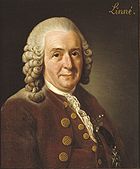 Carl Linnaeus laid the foundations for the modern scheme of binomial nomenclature. He is known as the father of modern taxonomy, and is also considered one of the fathers of modern ecology.
Carl Linnaeus laid the foundations for the modern scheme of binomial nomenclature. He is known as the father of modern taxonomy, and is also considered one of the fathers of modern ecology.
In the 18th century Sweden's scientific revolution took off. Previously, technical progress had mainly come from mainland Europe. In 1739, the Royal Swedish Academy of Sciences was founded, with people such as Carolus Linnaeus and Anders Celsius as early members. Many of the companies founded by early pioneers are still remain major international brands. Gustaf Dalén founded AGA, and received the Nobel Prize for his sun valve. Alfred Nobel invented dynamite and instituted the Nobel Prizes. Lars Magnus Ericsson started the company bearing his name, Ericsson, still one of the largest telecom companies in the world. Jonas Wenström was an early pioneer in alternating current and is along with Serbian inventor Nikola Tesla credited as one of the inventors of the three-phase electrical system.[123]
The traditional engineering industry is still a major source of Swedish inventions, but pharmaceuticals, electronics and other high-tech industries are gaining ground. Tetra Pak was an invention for storing liquid foods, invented by Erik Wallenberg. Losec, an ulcer medicine, was the world's best-selling drug in the 1990s and was developed by AstraZeneca. More recently Håkan Lans invented the Automatic Identification System, a worldwide standard for shipping and civil aviation navigation. A large portion of the Swedish economy is to this day based on the export of technical inventions, and many large multinational corporations from Sweden have their origins in the ingenuity of Swedish inventors.[123]
Swedish inventors hold a total of 33,523 patents in the United States as of 2007, according to the United States Patent and Trademark Office. As a nation, only ten other countries hold more patents than Sweden.[124]
Demographics
As of 2009[update], the total population of Sweden was estimated to be 9,325,429.[125] The population exceeded 9 million for the first time on approximately 12 August 2004 according to Statistics Sweden. The population density is 20.6 people per km² (53.3 per square mile) and it is substantially higher in the south than in the north. About 85% of the population live in urban areas.[12] The capital city Stockholm has a population of about 800,000 (with 1.3 million in the urban area and 2 million in the metropolitan area). The second and third largest cities are Gothenburg and Malmö.
Between 1820 and 1930, approximately 1.3 million Swedes, a third of the country's population, emigrated to North America, and most of them to the United States. There are more than 4.4 million Swedish Americans according to a 2006 U.S. Census Bureau estimate.[126] In Canada, the community of Swedish ancestry is 330,000 strong.[127]
Largest cities[128] # City Urban area population Metro population 1 Stockholm 1,372,565 2,019,182 2 Gothenburg 549,839 926,654 3 Malmö 280,415 635,224 4 Uppsala 140,454 5 Västerås 110,877 6 Örebro 107,038 7 Linköping 104,232 8 Helsingborg 97,122 9 Jönköping 89,396 10 Norrköping 87,247 Language
The official language of Sweden is Swedish,[8][9] a North Germanic language, related and very similar to Danish and Norwegian, but differing in pronunciation and orthography. Norwegians have little difficulty understanding Swedish, and Danes can also understand it, with slightly more difficulty than the Norwegians. The dialects spoken in Scania, the southernmost part of the country, are influenced by Danish because the region traditionally was a part of Denmark and is nowadays situated closely to it. Sweden Finns are Sweden's largest linguistic minority, comprising about 5% of Sweden's population,[2] and Finnish is recognized as a minority language.[9]
Along with Finnish, four other minority languages are also recognized: Meänkieli, Sami, Romani and Yiddish. Swedish became Sweden's official language on 1 July 2009, when a new language law was implemented.[9] The issue of whether Swedish should be declared the official language has been raised in the past, and the parliament voted on the matter in 2005, but the proposal narrowly failed.[129]
In varying degrees, depending largely on frequency of interaction with English, a majority of Swedes, especially those born after World War II, understand and speak English due to trade links, the popularity of overseas travel, a strong Anglo-American influence and the tradition of subtitling rather than dubbing foreign television shows and films, and the relative similarity of the two languages which makes learning English easier. In a 2005 survey by Eurobarometer, 89% of Swedes reported the ability to speak English.[130]
English became a compulsory subject for secondary school students studying natural sciences as early as 1849, and has been a compulsory subject for all Swedish students since the late 1940s.[131] Depending on the local school authorities, English is currently a compulsory subject between first grade and ninth grade, with all students continuing in secondary school studying English for at least another year. Most students also study one and sometimes two additional languages. These include (but are not limited to) German, French and Spanish. Some Danish and Norwegian is at times also taught as part of Swedish courses for native speakers.
Religion
Before the 11th century, Swedes adhered to Norse paganism, worshiping Æsir gods, with its centre at the Temple in Uppsala. With Christianization in the 11th century, the laws of the country were changed, forbidding worship of other deities into the late 19th century.
After the Protestant Reformation in the 1530s, a change led by Martin Luther's Swedish associate Olaus Petri, the authority of the Roman Catholic Church was abolished. The church and state were separated, allowing Lutheranism to prevail. This process was completed by the Uppsala Synod of 1593. Lutheranism became Sweden's official religion. During the era following the Reformation, usually known as the period of Lutheran Orthodoxy, small groups of non-Lutherans, especially Calvinist Dutchmen, the Moravian Church and Walloons or French Huguenots from Belgium, played a significant role in trade and industry, and were quietly tolerated as long as they kept a low religious profile. The Sami originally had their own shamanistic religion, but they converted to Lutheranism by the work of Swedish missionaries in the 17th and 18th centuries.
With religious liberalizations in the late 18th century believers of other faiths, including Judaism and Roman Catholicism, were allowed to openly live and work in the country. However, until 1860 it remained illegal for Lutheran Swedes to convert to another religion. The 19th century saw the arrival of various evangelical free churches, and, towards the end of the century, secularism, leading many to distance themselves from Church rituals. Leaving the Church of Sweden became legal with the so-called dissenter law of 1860, but only under the provision of entering another Christian denomination. The right to stand outside any religious denomination was formally established in the Law on Freedom of Religion in 1951. In 2000 the Church of Sweden was separated from the state and Sweden ceased to have any official church.
Church of Sweden[132][133] Year Population Church members Percentage 1972 8,146,000 7,754,784 95.2% 1980 8,278,000 7,690,636 92.9% 1990 8,573,000 7,630,350 89.0% 2000 8,880,000 7,360,825 82.9% 2005 9,048,000 6,967,498 77.0% 2006 9,119,000 6,893,901 75.6% 2007 9,179,000 6,820,161 74.3% 2008 9,262,000 6,751,952 72.9% 2009 – 6,664,064 71.3% [134] At the end of 2009, 71.3% of Swedes belonged to the Church of Sweden (Lutheran); this number has been decreasing by about 1% a year for the last two decades.[134][135] However, only approximately 2% of the church's members regularly attend Sunday services.[136] The reason for the large number of inactive members is partly that until 1996, children automatically became members at birth if at least one of the parents was a member. Since 1996, only children that are christened become members. Some 275,000 Swedes are today members of various free churches (where congregation attendance is much higher), and, in addition, immigration has meant that there are now some 92,000 Roman Catholics and 100,000 Eastern Orthodox Christians living in Sweden.[137]
Because of immigration, Sweden also has a significant Muslim population. They number about 500,000, but only approximately 5% (25,000) of these actively practice Islam (in the sense of attending Friday prayer and praying five times a day).[138]
Despite a high formal membership rate in the Church of Sweden, some studies have found Sweden to be one of the least religious countries in the world, with one of the highest levels of atheism. According to different studies, between 46% and 85% of Swedes do not believe in God.[139] In the Eurostat survey, 23% of Swedish citizens responded that "they believe there is a God", whereas 53% answered that "they believe there is some sort of spirit or life force" and 23% that "they do not believe there is any sort of spirit, God, or life force". Nevertheless, despite a lack of belief in God, these individuals resented the term atheist, and still called themselves Christians, being content with remaining in the Church of Sweden.[140] Other research has shown that religion in Sweden continues to play a role in cultural identity.[141] This is evidenced by the fact that around 80 percent of adults continue to remain members of the Lutheran Church despite having to pay a church tax; moreover, rates of baptism remain high and church weddings are increasing in Sweden.[141]
Health
Healthcare in Sweden is similar in quality to other developed nations. Sweden ranks in the top five countries with respect to low infant mortality. It also ranks high in life expectancy and in safe drinking water. A person seeking care first contacts a clinic for a doctor's appointment, and may then be referred to a specialist by the clinic physician, who may in turn recommend either in-patient or out-patient treatment, or an elective care option. The health care is governed by the 21 landsting of Sweden and is mainly funded by taxes, with nominal fees for patients.
Education
Children aged 1–5 years old are guaranteed a place in a public kindergarten (Swedish: förskola or, colloquially, dagis). Between the ages of 6 and 16, children attend compulsory comprehensive school. In the Programme for International Student Assessment (PISA), Swedish 15-year-old pupils score close to the OECD average.[142] After completing the 9th grade, about 90% of the students continue with a three-year upper secondary school (gymnasium), which can lead to both a job qualification or entrance eligibility to university. The school system is largely financed by taxes.
The Swedish government treats public and independent schools equally[143] by introducing education vouchers in 1992 as one of the first countries in the world after The Netherlands. Anyone can establish a for-profit school and the municipality must pay new schools the same amount as municipal schools get. School lunch is free for all students in Sweden, and usually includes one or two different kinds of hot meals, a vegetarian meal, salad bar, fruit, bread, milk and water. Some schools, especially kindergartens and middle schools, even serve breakfast for free[citation needed] to those who want to eat before school starts.
There are a number of different universities and colleges in Sweden, the oldest and largest of which are situated in Uppsala, Lund, Gothenburg and Stockholm. Only a few countries such as Canada, the United States, Japan and South Korea have higher levels of tertiary education degree holders.[citation needed] Along with several other European countries, the government also subsidises tuition of international students pursuing a degree at Swedish institutions, although a recent bill passed in the Swedish parliament will limit this subsidy to students from EEA countries and Switzerland.[144]
Immigration
Main article: Immigration to SwedenImmigration has been a major source of population growth and cultural change throughout much of the history of Sweden. Sweden has been transformed from a nation of emigration ending after World War I to a nation of immigration from World War II onwards. The economic, social, and political aspects of immigration have caused controversy regarding ethnicity, economic benefits, jobs for non-immigrants, settlement patterns, impact on upward social mobility, crime, and voting behaviour.
According to Eurostat, in 2010, there were 1.33 million foreign-born residents in Sweden, corresponding to 14.3% of the total population. Of these, 859 000 (9.2%) were born outside the EU and 477 000 (5.1%) were born in another EU Member State.[145][146] [147]
In 2009, immigration reached its highest level since records began with 102,280 people emigrating to Sweden.[148] Immigrants in Sweden are mostly concentrated in the urban areas of Svealand and Götaland.[147] Since the early 1970s, immigration to Sweden has been mostly due to refugee migration and family reunification from countries in the Middle East, Africa and Latin America.[149]
The largest groups in 2010 were:[147]
 Finland (172,218)
Finland (172,218) Former Yugoslavia (152,268)
Former Yugoslavia (152,268) Iraq (117,919)
Iraq (117,919) Poland (67,518)
Poland (67,518) Iran (59,922)
Iran (59,922) Germany (47,803)
Germany (47,803) Denmark (46,002)
Denmark (46,002) Norway (43,819)
Norway (43,819) Turkey (40,766)
Turkey (40,766) Somalia (31,734)
Somalia (31,734)
Culture
Sweden has many authors of worldwide recognition including August Strindberg, Astrid Lindgren, and Nobel Prize winners Selma Lagerlöf and Harry Martinson. In total seven Nobel Prizes in Literature have been awarded to Swedes. The nation's most well-known artists are painters such as Carl Larsson and Anders Zorn, and the sculptors Tobias Sergel and Carl Milles.
Swedish 20th-century culture is noted by pioneering works in the early days of cinema, with Mauritz Stiller and Victor Sjöström. In the 1920s–1980s, the filmmaker Ingmar Bergman and actors Greta Garbo and Ingrid Bergman became internationally noted people within cinema. More recently, the films of Lukas Moodysson and Lasse Hallström have received international recognition.
Throughout the 1960s and 1970s Sweden was seen as an international leader in what is now referred to as the "sexual revolution", with gender equality having particularly been promoted.[150] At the present time, the number of single people is one of the highest in the world. The early Swedish film I Am Curious (Yellow) (1967) reflected a liberal view of sexuality, including scenes of love making that caught international attention, and introduced the concept of the "Swedish sin".
Sweden has also become very liberal towards homosexuality, as is reflected in the popular acceptance of films such as Show Me Love, which is about two young lesbians in the small Swedish town of Åmål. Since 1 May 2009, Sweden repealed its "registered partnership" laws and fully replaced them with gender-neutral marriage, [151] Sweden also offers domestic partnerships for both same-sex and opposite-sex couples. Cohabitation (sammanboende) by couples of all ages, including teenagers as well as elderly couples, is widespread. Recently, Sweden is experiencing a baby boom.[152]
Music
Sweden has a rich musical tradition, ranging from mediaeval folk ballads to hip hop music. The music of the pre-Christian Norse has been lost to history, although historical re-creations have been attempted based on instruments found in Viking sites. The instruments used were the lur (a sort of trumpet), simple string instruments, wooden flutes and drums. It is possible that the Viking musical legacy lives on in some of the old Swedish folk music. Sweden has a significant folk-music scene, both in the traditional style as well as more modern interpretations which often mix in elements of rock and jazz. Väsen is more of a traditionalist group, using a unique, traditional Swedish instrument called the nyckelharpa while Garmarna, Nordman and Hedningarna have more modern elements. There is also Sami music, called the joik, which is actually a type of chant which is part of the traditional Saami animistic spirituality but has gained recognition in the international world of folk music. Sweden's most classic and notable composers includes Carl Michael Bellman and Franz Berwald.
Sweden also has a prominent choral music tradition, deriving in part from the cultural importance of Swedish folk songs. In fact, out of a population of 9.2 million, it is estimated that five to six hundred thousand people sing in choirs.[153]
Sweden is the third largest music exporter in the world,[154][155] with over 800 million dollars in 2007 years revenue, surpassed only by the US and the UK.[154] ABBA was one of the first internationally well-known popular music bands from Sweden, and still ranks among the most prominent bands in the world, with about 370 million records sold. With ABBA, Sweden entered into a new era, in which Swedish pop music gained international prominence.
There have been many other internationally successful bands since, such as Roxette, Ace of Base, Europe, A-teens, The Cardigans and The Hives, to name some of the biggest, and recently there has been a surge of Swedish Indie pop bands such as Loney, Dear, Shout Out Louds, The Radio Dept. and Dungen, a group which incorporates many elements of Swedish traditional folk music in their sound. One of the biggest bands in Sweden is the rock band Kent.
Sweden has also become known for a large number of heavy metal (mostly death metal and melodic death metal) as well as progressive- and power metal bands. Some of the most popular being In Flames, Amon Amarth, HammerFall, Pain of Salvation, Dark Tranquillity, Opeth, Arch Enemy and Meshuggah. The renowned neoclassical power metal guitarist Yngwie Malmsteen is also from Sweden.
Sweden has a rather lively jazz scene. During the last sixty years or so it has attained a remarkably high artistic standard, stimulated by domestic as well as external influences and experiences. The Centre for Swedish Folk Music and Jazz Research has published an overview of jazz in Sweden by Lars Westin.[156]
Architecture
Before the 13th century most buildings were made of brick, but a shift began towards stone. Early Swedish stone buildings are the Romanesque churches on the country side. As so happens, many of them were built in Scania and are in effect Danish churches. This would include the magnificent Lund Cathedral from the 11th century and the somewhat younger church in Dalby, but also many early Gothic churches built through influences of the Hanseatic League, such as in Ystad, Malmö and Helsingborg.
Cathedrals in other parts of Sweden were also built as seats of Sweden's bishops. The Skara Cathedral is of bricks from the 14th century, and the Uppsala Cathedral in the 15th. In 1230 the foundations of the Linköping Cathedral were made, the material was there limestone, but the building took some 250 years to finish.
Among older structures are also some significant fortresses and other historical buildings such as at Borgholm Castle, Halltorps Manor and Eketorp fortress on the island Öland, the Nyköping fortress and the Visby ring wall.
Around 1520 Sweden was out of the Middle Ages and united under King Gustav Vasa, who immediately initiated grand mansions, castles and fortresses to be built. Some of the more magnificent include the Kalmar fortress, the Gripsholm Castle and the one at Vadstena.
In the next two centuries, Sweden was designated by Baroque architecture and later the rococo. Notable projects from that time include the city Karlskrona, which has now also been declared a World Heritage Site and the Drottningholm Palace.
1930 was the year of the great Stockholm exhibition, which marked the breakthrough of Functionalism, or "funkis" as it became known. The style came to dominate in the following decades. Some notable projects of this kind were the Million Programme, offering affordable but anti-human living in large apartment complexes.
Media
Swedes are among the greatest consumers of newspapers in the world, and nearly every town is served by a local paper. The country's main quality morning papers are Dagens Nyheter (liberal), Göteborgs-Posten (liberal), Svenska Dagbladet (liberal conservative) and Sydsvenska Dagbladet (liberal). The two largest evening tabloids are Aftonbladet (social democratic) and Expressen (liberal). The ad-financed, free international morning paper, Metro International, was originally founded in Stockholm, Sweden. The country's news is reported in English by, among others, The Local (liberal).
The public broadcasting companies held a monopoly on radio and television for a long time in Sweden. Licence funded radio broadcasts started in 1925. A second radio network was started in 1954 and a third opened 1962 in response to pirate radio stations. Non-profit community radio was allowed in 1979 and in 1993 commercial local radio started.
The licence funded television service was officially launched in 1956. A second channel, TV2, was launched in 1969. These two channels (operated by Sveriges Television since the late '70s) held a monopoly until the 1980s when cable and satellite television became available. The first Swedish language satellite service was TV3 which started broadcasting from London in 1987. It was followed by Kanal 5 in 1989 (then known as Nordic Channel) and TV4 in 1990.
In 1991 the government announced it would begin taking applications from private television companies wishing to broadcast on the terrestrial network. TV4, which had previously been broadcasting via satellite, was granted a permit and began its terrestrial broadcasts in 1992, becoming the first private channel to broadcast television content from within the country.
Around half the population are connected to cable television. Digital terrestrial television in Sweden started in 1999 and the last analogue terrestrial broadcasts were terminated in 2007.
Literature
The first literary text from Sweden is the Rök Runestone, carved during the Viking Age c. 800 AD. With the conversion of the land to Christianity around 1100 AD, Sweden entered the Middle Ages, during which monastic writers preferred to use Latin. Therefore there are only a few texts in the Old Swedish from that period. Swedish literature only flourished when the Swedish language was standardized in the 16th century, a standardization largely due to the full translation of the Bible into Swedish in 1541. This translation is the so-called Gustav Vasa Bible.
With improved education and the freedom brought by secularization, the 17th century saw several notable authors develop the Swedish language further. Some key figures include Georg Stiernhielm (17th century), who was the first to write classical poetry in Swedish; Johan Henric Kellgren (18th century), the first to write fluent Swedish prose; Carl Michael Bellman (late 18th century), the first writer of burlesque ballads; and August Strindberg (late 19th century), a socio-realistic writer and playwright who won worldwide fame. The early 20th century continued to produce notable authors, such as Selma Lagerlöf, (Nobel laureate 1909), Verner von Heidenstam (Nobel laureate 1916) and Pär Lagerkvist (Nobel laureate 1951).
In recent decades, a handful of Swedish writers have established themselves internationally, including the detective novelist Henning Mankell and the writer of spy fiction Jan Guillou. The Swedish writer to have made the most lasting impression on world literature is the children's book writer Astrid Lindgren, and her books about Pippi Longstocking, Emil, and others. In 2008, the second best-selling fiction author in the world was Stieg Larsson, whose Millennium series of crime novels is being published posthumously to critical acclaim.[157] Larsson drew heavily on the work of Lindgren by basing his central character, Lisbeth Salander, on Longstocking.[158]
Holidays
Apart from traditional Protestant Christian holidays, Sweden also celebrates some unique holidays, some of a pre-Christian tradition. They include Midsummer celebrating the summer solstice; Walpurgis Night (Valborgsmässoafton) on 30 April lighting bonfires; and Labour Day or Mayday on 1 May is dedicated to socialist demonstrations. The day of giver-of-light Saint Lucia, 13 December, is widely acknowledged in elaborate celebrations which betoken its Italian origin and commence the month-long Christmas season.
6 June is the National Day of Sweden and, as of 2005, a public holiday. Furthermore, there are official flag day observances and a Namesdays in Sweden calendar. In August many Swedes have kräftskivor (crayfish dinner parties). Martin of Tours Eve is celebrated in Scania in November with Mårten Gås parties, where roast goose and svartsoppa ('black soup', made of goose stock, fruit, spices, spirits and goose blood) are served. The Sami, one of Sweden's indigenous minorities, have their holiday on 6 February and Scania celebrate their Scanian Flag day on the third Sunday in July.
Cuisine
Swedish cuisine, like that of the other Scandinavian countries (Denmark, Norway and Finland), was traditionally simple. Fish (particularly herring), meat, potatoes and dairy products played prominent roles.
Spices were sparse. Famous dishes include Swedish meatballs, traditionally served with gravy, boiled potatoes and lingonberry jam; pancakes, lutfisk, and Smörgåsbord, or lavish buffet. Akvavit is a popular alcoholic distilled beverage, and the drinking of snaps is of cultural importance. The traditional flat and dry crisp bread has developed into several contemporary variants. Regionally important foods are the surströmming (a fermented fish) in Northern Sweden and eel in Scania in Southern Sweden.
Swedish traditional dishes, some of which are many hundreds of years old, others perhaps a century or less, are still a very important part of Swedish everyday meals, in spite of the fact that modern day Swedish cuisine adopts many international dishes.
In August, at the traditional feast known as crayfish party, kräftskiva, Swedes eat large amounts of boiled crayfish with boiled potato and dill.
Cinema
Swedes have been fairly prominent in the film area through the years, several successful Swedish Hollywood actors can be mentioned: Ingrid Bergman, Greta Garbo, Max von Sydow, Dolph Lundgren, Lena Olin, Britt Ekland, Maud Adams, Stellan Skarsgård, Peter Stormare, Izabella Scorupco, Pernilla August, Ann-Margret, Anita Ekberg, Alexander Skarsgård, Harriet Andersson, Bibi Andersson, Ingrid Thulin, Malin Åkerman and Gunnar Björnstrand. Amongst several directors who have made internationally successful films can be mentioned: Ingmar Bergman, Lukas Moodysson and Lasse Hallström.
Fashion
Interest in fashion is big in Sweden and the country is headquartering famous brands like Hennes & Mauritz (operating as H&M), J. Lindeberg (operating as JL), Acne, Gina Tricot, Lindex, Tiger of Sweden, Odd Molly, Cheap Monday, Dr. Denim, Gant, Resteröds, Nudie Jeans, WESC, WAX, Uniforms for the Dedicated, Filippa K, Nakkna and Fifth Avenue Shoe Repair within its borders. These companies, however, are composed largely of buyers who import fashionable goods from throughout Europe and America, continuing the trend of Swedish business toward multinational economic dependency like many of its neighbours.
Sports
Sport activities are a national movement with half of the population actively participating, much thanks to the heavy government subsidies of sport associations (föreningsstöd). The two main spectator sports are football and ice hockey. Second to football, horse sports have the highest number of practitioners, mostly women. Thereafter follow golf, athletics, and the team sports of handball, floorball, basketball and bandy.
The Swedish ice hockey team Tre Kronor is regarded as one of the best in the world. The team has won the World Championships eight times, placing them third in the all-time medal count. Tre Kronor also won Olympic gold medals in 1994 and 2006. In 2006, Tre Kronor became the first national hockey team to win both the Olympic and world championships in the same year. The Swedish national football team has seen some success at the World Cup in the past, finishing second when they hosted the tournament in 1958, and third twice, in 1950 and 1994. Athletics has enjoyed a surge in popularity due to several successful athletes in recent years, such as Carolina Klüft, Stefan Holm, Christian Olsson, Patrik Sjöberg, Johan Wissman and Kajsa Bergqvist.
Sweden is also the seventh most successful country in the Olympic Games, as of 2010.
In schools, on meadows and in parks, the game brännboll, a sport similar to baseball, is commonly played for fun. Other leisure sports are the historical game of kubb, and boules among the older generation.
Sweden hosted the 1912 Summer Olympics and the FIFA World Cup in 1958. Other big sports events held here include 1992 UEFA European Football Championship, FIFA Women's World Cup 1995, and several championships of ice hockey, curling, athletics, skiing, bandy, figure skating and swimming.
Successful tennis players include former world No. 1's Björn Borg, Mats Wilander and Stefan Edberg.
Other famous Swedish athletes include the heavyweight boxing champion and International Boxing Hall of Famer – Ingemar Johansson; World Golf Hall of Famer – Annika Sörenstam and multiple World Championships and Olympics medalist in table tennis – Jan-Ove Waldner.
Arne Borg, Gunnar Larsson, Anders Holmertz, Stefan Nystrand, Therese Alshammar, Anna-Karin Kammerling, Emma Igelström are some of the renowned swimmers, who have been successful in Olympics and/or World Championships.
Notable in motorsports are: Two time DTM (Deutsche Tourenwagen Masters) and Race of Champions winner Mattias Ekström, Multiple Speedway World Champion Tony Rickardsson; British Touring Car Champion Rickard Rydell and the IRL and Indy 500 champion Kenny Bräck, F1 Grand Prix winner, Ronnie Peterson and Björn Waldegård who won the Safari Rally in 1977, the Monte Carlo Rally in 1969 and 1970 as well as the British RAC Rally in 1977.
Sweden has also been internationally successful in equestrian (Malin Baryard), golf (Jesper Parnevik, Annika Sörenstam) and speed-skating.
In cycling Sweden has the 1971 Giro winner Gösta Pettersson, two-time Giro runner up Tommy Prim, 2004 Paris-Roubaix winner Magnus Bäckstedt as well as several other top professional cyclists including current riders Thomas Lövkvist, Gustav Larsson and Fredrik Kessiakoff.
See also
Articles related to Sweden  Sweden topics
Sweden topicsHistory 
Politics and
governmentGeography Economy Military Demographics - Education
- Ethnic minorities
- Languages
- Religion
- Subdivisions
- Cities
- People
- Healthcare
- Immigration
Media Culture Symbols Portal  Geographic locale
Geographic localeSovereign states and dependent territories of Europe Sovereign states Albania · Andorra · Armenia · Austria · Azerbaijan · Belarus · Belgium · Bosnia and Herzegovina · Bulgaria · Croatia · Cyprus · Czech Republic · Denmark · Estonia · Finland · France · Georgia · Germany · Greece · Hungary · Iceland · Ireland · Italy · Kazakhstan · Latvia · Liechtenstein · Lithuania · Luxembourg · Macedonia · Malta · Moldova · Monaco · Montenegro · Netherlands · Norway · Poland · Portugal · Romania · Russia · San Marino · Serbia · Slovakia · Slovenia · Spain · Sweden · Switzerland · Turkey · Ukraine · United Kingdom · Vatican City
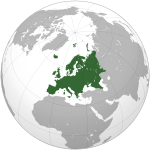
States with limited recognition Dependencies and other territories DenmarkFinlandUnited KingdomReferences
- Footnotes
- ^ "Befolkningsstatistik". www.scb.se. http://www.scb.se/Pages/Product____25785.aspx?produktkod=BE0101&displaypressrelease=true&pressreleaseid=257212. Retrieved 2009-06-16.
- ^ a b "På lördag kan 440 000 flagga blått och vitt" (in Swedish). www.scb.se. 2008-12-05. http://www.scb.se/Pages/PressRelease____255905.aspx. Retrieved 2009-06-16.
- ^ "Summary of Population Statistics 1960–2008". www.scb.se. http://www.scb.se/Pages/TableAndChart____26041.aspx. Retrieved 2010-06-03.
- ^ Note that Swedish-speaking Finns or other Swedish-speakers born outside Sweden might self-identify as Swedish despite being born abroad. Moreover, people born within Sweden may not be ethnic Swedes.
- ^ a b "Befolkningsstatistik". Statistiska centralbyrån. http://www.scb.se/Pages/Product____25799.aspx. Retrieved 2010-05-18.
- ^ a b c d "Sweden". International Monetary Fund. http://www.imf.org/external/pubs/ft/weo/2010/01/weodata/weorept.aspx?sy=2007&ey=2010&scsm=1&ssd=1&sort=country&ds=.&br=1&c=144&s=NGDPD%2CNGDPDPC%2CPPPGDP%2CPPPPC%2CLP&grp=0&a=&pr.x=10&pr.y=12. Retrieved 2010-04-21.
- ^ "Human Development Report 2010". United Nations. 2010. http://hdr.undp.org/en/media/HDR_2010_EN_Table1.pdf. Retrieved 5 November 2010.
- ^ a b "Språklagen" (in Swedish). Språkförsvaret. 2009-07-01. http://www.sprakforsvaret.se/sf/fileadmin/PDF/spraklagen_200509.pdf. Retrieved 2009-07-15.
- ^ a b c d Landes, David (2009-07-01). "Swedish becomes official 'main language'". The Local. thelocal.se. http://www.thelocal.se/20404/20090701/. Retrieved 2009-07-15.
- ^ "Är svenskan också officiellt språk i Sverige?" (in Swedish). Språkrådet (Language Council of Sweden). 2008-02-01. http://www.sprakradet.se/servlet/GetDoc?meta_id=2119#item100400. Retrieved 2008-06-22.
- ^ Summary of Population Statistics 1960 – 2008 – Statistics Sweden (proportion of foreign background, including foreign-born and Swedish-born with two foreign-born parents)
- ^ a b Statistics Sweden. Yearbook of Housing and Building Statistics 2007. Statistics Sweden, Energy, Rents and Real Estate Statistics Unit, 2007. ISBN 978-91-618-1361-2. Available online in PDF format
- ^ "''U.S. State Department Background Notes: Sweden''". State.gov. 2010-03-22. http://www.state.gov/r/pa/ei/bgn/2880.htm#foreign. Retrieved 2010-08-25.
- ^ Klaus Schwab The Global Competitiveness Report 2010–2011. World Economic Forum, Geneva, Switzerland 2010 ISBN 92-95044-87-8
- ^ Hellquist, Elof (1922). Svensk etymologisk ordbok. Stockholm: Gleerups förlag. p. 917. http://runeberg.org/svetym/1005.html.
- ^ Hellquist, Elof (1922). Svensk etymologisk ordbok. Stockholm: Gleerups förlag. p. 915.
- ^ Goth (people). Britannica Online Encyclopedia.
- ^ Ingemar Nordgren (2004). "The Well Spring of the Goths: About the Gothic Peoples in the Nordic Countries and on the Continent". iUniverse. p. 520 ISBN 0595336485
- ^ Quoted from: Gwyn Jones. A History of the Vikings. Oxford University Press, 2001. ISBN 0-19-280134-1. Page 164.
- ^ a b Sawyer, Birgit and Peter Sawyer (1993). Medieval Scandinavia: from Conversion to Reformation, Circa 800–1500. University of Minnesota Press, 1993. ISBN 0-8166-1739-2, pp. 150–153.
- ^ Bagge, Sverre (2005) "The Scandinavian Kingdoms". In The New Cambridge Medieval History. Eds. Rosamond McKitterick et al. Cambridge University Press, 2005. ISBN 0-521-36289-X, p. 724: "Swedish expansion in Finland led to conflicts with Rus', which were temporarily brought to an end by a peace treaty in 1323, dividing the Karelian peninsula and the northern areas between the two countries."
- ^ Franklin D. Scott, Sweden: The Nation's History (University of Minnesota Press: Minneapolis, 1977) p. 58.
- ^ Träldom. Nordisk familjebok / Uggleupplagan. 30. Tromsdalstind – Urakami /159–160, 1920. (In Swedish)
- ^ Scott, p. 55.
- ^ Scott, pp. 55–56.
- ^ Scott, pp. 56–57.
- ^ Scott, p. 121.
- ^ Scott, p. 132.
- ^ Robert S. Hoyt & Stanley Chodorow, Europe in the Middle Ages (Harcourt, Brace & Jovanovich, Inc.: New York, 1976) p. 628.
- ^ John B. Wolfe, The Emergence of European Civilization (Harper & Row Pub.: New York, 1962) pp. 50–51.
- ^ Scott, p. 52.
- ^ Scott
- ^ Scott, pp. 156–157.
- ^ "Population". History Learningsite. http://www.historylearningsite.co.uk/population_thirty_years_war.htm. Retrieved 2008-05-24.
- ^ "A Political and Social History of Modern Europe V.1./Hayes..." Hayes, Carlton J. H. (1882–1964), Title: A Political and Social History of Modern Europe V.1., 2002-12-08, Project Gutenberg, webpage: Infomot-7hsr110.
- ^ However, Sweden's largest territorial extent lasted from 1319 to 1343 with Magnus Eriksson ruling all of the traditional lands of Sweden and Norway.
- ^ "Gustav I Vasa – Britannica Concise" (biography), Britannica Concise, 2007, webpage: EBConcise-Gustav-I-Vasa.
- ^ "Battle of Kircholm 1605". Kismeta.com. http://www.kismeta.com/diGrasse/images/kircholm_27_sept.htm. Retrieved 2010-08-25.
- ^ Finland and the Swedish Empire. Source: U.S. Library of Congress
- ^ Agricultural Yields and Years of Famine – Sweden. Hans Högman.
- ^ Elizabeth Ewan, Janay Nugent (2008) "Finding the family in medieval and early modern Scotland". Ashgate Publishing. p. 153 ISBN 0-7546-6049-4
- ^ Losses statistics at Militaria. (Swedish)
- ^ Paul Robert Magocsi, editor.; Paul Robert Magocsi (1998). Encyclopedia of Canada's Peoples. University of Minnesota Press. p. 1220. ISBN 0-8020-2938-8.
- ^ a b Einhorn, Eric and John Logue (1989). Modern Welfare States: Politics and Policies in Social Democratic Scandinavia. Praeger Publishers, p. 9: "Though Denmark, where industrialization had begun in the 1850s, was reasonably prosperous by the end of the nineteenth century, both Sweden and Norway were terribly poor. Only the safety valve of mass emigration to America prevented famine and rebellion. At the peak of emigration in the 1880s, over 1% of the total population of both countries emigrated annually."
- ^ Koblik, Steven (1975). Sweden's Development from Poverty to Affluence 1750–1970, University of Minnesota Press, pp. 8–9, "In economic and social terms the eighteenth century was more a transitional than a revolutionary period. Sweden was, in light of contemporary Western European standards, a relatively poor but stable country. [...] It has been estimated that 75–80% of the population was involved in agricultural pursuits during the late eighteenth century. One hundred years later, the corresponding figure was still 72%."
- ^ Einhorn, Eric and John Logue (1989), p. 8.
- ^ Ulf Beijbom, "European emigration", The House of Emigrants, Växjö, Sweden.
- ^ a b Koblik, pp. 9–10.
- ^ Sweden: Social and economic conditions (2007). In Encyclopædia Britannica. Encyclopædia Britannica Online. Retrieved 19 February 2007.
- ^ Koblik, p. 11: "The agrarian revolution in Sweden is of fundamental importance for Sweden's modern development. Throughout Swedish history the countryside has taken an unusually important role in comparison with other European states."
- ^ Koblik, p. 90. "It is usually suggested that between 1870 and 1914 Sweden emerged from its primarily agrarian economic system into a modern industrial economy."
- ^ a b c Koblik, pp. 303–313.
- ^ Nordstrom, p. 315: "Sweden's government attempted to maintain at least a semblance of neutrality while it bent to the demands of the prevailing side in the struggle. Although effective in preserving the country's sovereignty, this approach generated criticism at home from many who believed the threat to Sweden was less serious than the government claimed, problems with the warring powers, ill feelings among its neighbours, and frequent criticism in the postwar period."
- ^ a b c d e Nordstrom, pp. 313–319.
- ^ Zubicky, Sioma (1997) (in Swedish). Med förintelsen i bagaget. Stockholm: Bonnier Carlsen. p. 122. ISBN 91-638-3436-7.
- ^ "Raoul Wallenberg". Jewish Virtual Library.
- ^ a b Nordstrom, pp. 335–339.
- ^ a b Globalization and Taxation: Challenges to the Swedish Welfare State. By Sven Steinmo.
- ^ Nordstrom, p. 344: "During the last twenty-five years of the century a host of problems plagued the economies of Norden and the West. Although many were present before, the 1973 and 1980 global oil crises acted as catalysts in bringing them to the fore."
- ^ Krantz, Olle and Lennart Schön. 2007. Swedish Historical National Accounts, 1800–2000. Lund: Almqvist and Wiksell International.
- ^ Englund, P. 1990. "Financial deregulation in Sweden." European Economic Review 34 (2–3): 385–393. Korpi TBD. Meidner, R. 1997. "The Swedish model in an era of mass unemployment." Economic and Industrial Democracy 18 (1): 87–97. Olsen, Gregg M. 1999. "Half empty or half full? The Swedish welfare state in transition." Canadian Review of Sociology & Anthropology, 36 (2): 241–268.
- ^ "Sweden's `Crazy' 500% Interest Rate; Fails to Faze Most Citizens, Businesses; Hike Seen as Short-Term Move to Protect Krona From Devaluation". Highbeam.com. 1992-09-18. http://www.highbeam.com/doc/1P2-1025624.html. Retrieved 2010-08-03.
- ^ Lars Jonung, Jaakko Kiander, Pentti Vartia (2009). The Great Financial Crisis in Finland and Sweden. Edward Elgar Publishing. ISBN 1848443056. http://books.google.com/books?id=NxFh9qk0wBYC&pg=PA44.
- ^ The Local. "New Swedish weapon in Iraq". http://www.thelocal.se/article.php?ID=3013&date=20060207. Retrieved 2007-06-23.
- ^ "Country Comparison: Area". Central Intelligence Agency. Cia.gov. https://www.cia.gov/library/publications/the-world-factbook/rankorder/2147rank.html?countryName=Sweden&countryCode=sw®ionCode=eu&rank=55#sw. Retrieved 19 August 2010.
- ^ "BBC Climate and the Gulf Stream". http://www.bbc.co.uk/climate/impact/gulf_stream.shtml. Retrieved 2008-10-29.
- ^ "The Gulf Stream Myth". http://www.ldeo.columbia.edu/res/div/ocp/gs/. Retrieved 2008-10-29.
- ^ "Global Climate Maps". http://www.fao.org/WAICENT/FAOINFO/SUSTDEV/EIdirect/climate/EIsp0002.htm.
- ^ "Number of hours with sunshine (map)". Swedish Meteorological Institute. http://www.smhi.se/cmp/jsp/polopoly.jsp?d=7608&a=21429&l=sv.[dead link]
- ^ "Normal solskenstid för ett år | SMHI" (in (Swedish)). Smhi.se. http://www.smhi.se/klimatdata/meteorologi/stralning/1.3052. Retrieved 2010-01-27.
- ^ "July average high temperature map". Swedish Meteorological Institute. http://www.smhi.se/cmp/jsp/polopoly.jsp?d=7628&a=21614&l=sv.[dead link]
- ^ "July average low temperature map". Swedish Meteorological Institute. http://www.smhi.se/cmp/jsp/polopoly.jsp?d=7628&a=21654&l=sv.[dead link]
- ^ "January daily average temperature map". Swedish Meteorological Institute. http://www.smhi.se/cmp/jsp/polopoly.jsp?d=7628&a=21572&l=sv.[dead link]
- ^ "Date of first autumn frost (map)". Swedish Meteorological Institute. http://www.smhi.se/cmp/jsp/polopoly.jsp?d=7628&a=21704&l=sv.[dead link]
- ^ "Date of last spring frost (map)". Swedish Meteorological Institute. http://www.smhi.se/cmp/jsp/polopoly.jsp?d=7628&a=21706&l=sv.[dead link]
- ^ "Low temperature extremes". Swedish Meteorological Institute. http://www.smhi.se/cmp/jsp/polopoly.jsp?d=7522&a=20978&l=sv.[dead link]
- ^ "High temperature extremes". Swedish Meteorological Institute. http://www.smhi.se/cmp/jsp/polopoly.jsp?d=7522&a=20974&l=sv.[dead link]
- ^ "Annual precipitation map". Swedish Meteorological Institute. http://www.smhi.se/cmp/jsp/polopoly.jsp?d=7618&a=21516&l=sv.[dead link]
- ^ "Sweden's climate". Swedish Meteorological Institute. http://www.smhi.se/cmp/jsp/polopoly.jsp?d=5441.[dead link] (in Swedish, see also the Google-translated version)
- ^ weather. "Local, National, and International Weather – Forecasts, Radar Maps, Video, and News". Msn.com. Archived from the original on 2008-05-11. http://web.archive.org/web/20080511023744/http://www.msn.com/weather. Retrieved 2009-05-06.
- ^ [1][dead link]
- ^ Hadenius, Stig; Nilsson, Torbjörn; Åselius, Gunnar (1996) Sveriges historia: vad varje svensk bör veta. Bonnier Alba, Borås. ISBN 91-34-51857-6 (in Swedish) (1996:13):
Hur och när det svenska riket uppstod vet vi inte. Först under 1100-talet börjar skriftliga dokument produceras i Sverige i någon större omfattning [...] How and when the Swedish kingdom appeared is not known. It is not until the 12th century that written document begin to be produced in Sweden in any larger extent [...] - ^ Kungl. Maj:ts kungörelse med anledning av konung Gustaf VI Adolfs frånfälle. SFS 1973:702. Justitiedepartementet L6, 19 September 1973.
- ^ a b The Swedish Parliament. The history of the Riksdag. Retrieved 13 February 2007.
- ^ European Commission Directorate General for Employment, Social Affairs And Equal Opportunities, Report On The Equality Between Men And Women,http://ec.europa.eu/employment_social/publications/2006/keaj06001_en.pdf February 2006
- ^ "Nordic countries rank highest in gender equality". Norden.org. http://www.norden.org/webb/news/news.asp?lang=6&id=6605. Retrieved 2009-05-06.
- ^ BBC News (2010-09-20). "Swedish far-right wins first seats in parliament". http://www.bbc.co.uk/news/world-europe-11367622. Retrieved 2011-09-01.
- ^ {{cite web|url=http://www.riksdagen.se/templates/R_SubStartPage____272.aspx%7Ctitle=Ledamöter & partier|author=Sveriges riksdag}}
- ^ The Official Website of the Swedish Election Authority. "Val till riksdagen". http://www.val.se/val/val2006/slutlig/R/rike/roster.html.
- ^ Sören Holmberg (1999). Pippa Norris. ed. Critical Citizens: Global Support for Democratic Government. Oxford University Press. pp. 103–123. ISBN 0198295685.
- ^ van Dijk, Jan; Robert Manchin, John van Kesteren, Sami Nevala, Gergely Hideg (2005). "EUICS report, The Burden of Crime in the EU, A Comparative Analysis of the" (PDF). http://www.gallup-europe.be/downloads/EUICS%20-%20The%20Burden%20of%20Crime%20in%20the%20EU.pdf.
- ^ Nordstrom p. 302: "In fact, the plans were mostly a ruse to establish control of the crucial Norwegian port of Narvik and the iron mines of northern Sweden, which were vitally important to the German war efforts."
- ^ As context, according to Edwin Reischauer, "To be neutral you must be ready to be highly militarized, like Switzerland or Sweden." – see Chapin, Emerson. "Edwin Reischauer, Diplomat and Scholar, Dies at 79," New York Times. September 2, 1990.
- ^ Nordstrom, p 336: "As a corollary, a security policy based on strong national defences designed to discourage, but not prevent, attack was pursued. For the next several decades, the Swedish poured an annual average of about 5% of GDP into making their defenses credible."
- ^ National Geographical News, web article, Cold War Spy Plane Found in Baltic Sea[2] 10 November 2003.
- ^ "Värnplikt [Conscription"]. http://www.forsvarsmakten.se/sv/Rekrytering/Varnplikt/. Retrieved 2010-04-21.[dead link]
- ^ "Allmänna värnplikten skrotas [General conscription scrapped"]. http://svt.se/2.22620/1.1595556/allmanna_varnplikten_skrotas?lid=puff_1597044&lpos=extra_0. Retrieved 2010-04-21.
- ^ "Military conscription phase out under fire". http://www.thelocal.se/21494/20090816/. Retrieved 2010-04-21.
- ^ Swedish Ministry of Defence (2008-01-08). "The EU Battlegroup Concept and the Nordic Battlegroup". Government Offices of Sweden. http://www.sweden.gov.se/sb/d/9133/a/82276. Retrieved 2008-01-19.
- ^ "Doing Business Abroad – Innovation, Science and Technology". Infoexport.gc.ca. Archived from the original on 2006-10-04. http://web.archive.org/web/20061004050916/http://www.infoexport.gc.ca/science/nordics_sweden_report-en.htm. Retrieved 2009-05-06.
- ^ "20 largest companies in Sweden". Largestcompanies.com. 2009-10-06. http://www.largestcompanies.com/default$/lev2-TopList/lev2Desc-The_largest_companies_in_the_Nordic_countries_by%A0turnover%A0%28excl._national_subsidiaries%29/AdPageId-102/list-2/cc-SE/. Retrieved 2010-08-25.
- ^ a b c d e f "Economic survey of Sweden 2007". Oecd.org. 1970-01-01. http://www.oecd.org/document/37/0,3343,en_2649_34569_38048997_1_1_1_1,00.html. Retrieved 2010-08-25.
- ^ Pension Reform in Sweden: Lessons for American Policymakers by Goran Normann, Ph.D. and Daniel J. Mitchell, Ph.D. June 29, 2000.
- ^ a b OECD Economic Surveys: Sweden – Volume 2005 Issue 9 by OECD Publishing
- ^ "World Economic Forum – Global Competitiveness Report". Weforum.org. 2009-11-25. http://www.weforum.org/en/initiatives/gcp/Global%20Competitiveness%20Report/index.htm. Retrieved 2009-11-25.
- ^ "World Economic Forum – Global Competitiveness Report". Weforum.org. 2010-09-11. http://www.weforum.org/en/initiatives/gcp/Global%20Competitiveness%20Report/index.htm. Retrieved 2010-09-11.
- ^ "IMD Competitiveness Yearbook 2008". Imd.ch. 2007-01-23. http://www.imd.ch/research/publications/wcy/index.cfm. Retrieved 2010-08-25.
- ^ "Sweden most creative country in Europe & top talent hotspot[dead link], Invest in Sweden Agency, 25 June 2005.
- ^ Kraftläget i Sverige, Vattensituationen[dead link]
- ^ "Nuclear Power in Sweden". World Nuclear Association. September 2009. http://world-nuclear.org/info/inf42.html. Retrieved 2010-01-29.
- ^ a b Ministry of Foreign Affairs, Sweden. Agenda 21 – Natural Resource Aspects – Sweden. 5th Session of the United Nations Commission on Sustainable Development, April 1997.
- ^ Vidal, John. Sweden plans to be world's first oil-free economy. The Guardian, 2/8/06. Retrieved 2/13/07.
- ^ Kicking Away The Ladder, pp. 39–42, Ha-Joon Chang.
- ^ [3], Richard Wilkinson & Kate Pickett
- ^ a b EU versus USA, Fredrik Bergström & Robert Gidehag
- ^ Sweden's GDP per capita Ekonomifakta
- ^ Sweden's balancing lessons for Europe, McKinsey IMG institute 2006
- ^ Moderate revolution, The Economist September 13, 2007
- ^ Lindberg, Henrik. "The Role of Economists in Liberalising Swedish Agriculture" (May 2007). [4]
- ^ Westerlund, Kenneth (2008-03-11). "Danmark har högsta skattetrycket". DN. http://www.dn.se/DNet/jsp/polopoly.jsp?d=3130&a=750879. Retrieved 2008-03-11.
- ^ "Unemployment rate in December 2008 (SCB, Statistics Sweden, central government authority for official statistics)". Scb.se. http://www.scb.se/Pages/PressArchive____259760.aspx?PressReleaseID=258940. Retrieved 2010-08-25.
- ^ "Embassy of Sweden New Delhi – Science & Technology". Swedenabroad.se. http://www.swedenabroad.se/Page____50008.aspx. Retrieved 2009-05-06.
- ^ a b "Innovation, Science/Research: Inventing tomorrow's world". Fact Sheet FS 4. Sweden.se. February 2010. http://www.sweden.se/eng/Home/Education/Research/Facts/Innovation/. Retrieved 2011-01-27.
- ^ Patents By Country, State, and Year – All Patent Types (December 2007)[5]
- ^ Statistics Sweden. 2004–2006 Preliminary Population, by month. Population statistics, 1 January 2007. Retrieved 14 February 2007.
- ^ "United States – Selected Social Characteristics: 2006". U.S. Census Bureau. http://factfinder.census.gov/servlet/ADPTable?_bm=y&-geo_id=01000US&-ds_name=ACS_2006_EST_G00_. Retrieved 2011-01-15.
- ^ "Ethnocultural Portrait of Canada Highlight Tables, 2006 Census". http://www12.statcan.ca/english/census06/data/highlights/ethnic/pages/Page.cfm?Lang=E&Geo=PR&Code=01&Data=Count&Table=2&StartRec=1&Sort=3&Display=All&CSDFilter=5000. Retrieved 2008-06-30.
- ^ http://www.scb.se/Pages/ProductTables____13001.aspx
- ^ Svenskan blir inte officiellt språk (Swedish official languages), Sveriges Television, 2005-12-07. Retrieved on July 23, 2006 (in Swedish).
- ^ "Languages" (PDF), Europa.eu, webpage: Doc631-PDF.
- ^ "English spoken – fast ibland hellre än bra" (in Swedish). Lund University newsletter 7/1999. http://www3.lu.se/info/lum/LUM_07_99/01_engelska.html.
- ^ (Swedish) Svenska Kyrkan Statistiek pagina Medlemmar 1972–2008 excel file
- ^ (Swedish) [http://www.svenskakyrkan.se/default.aspx?id=100243&did=340397 Svenska kyrkans medlemsutveckling år 1972–2009
- ^ a b "Swedes depart church in droves". Thelocal.se. http://www.thelocal.se/26878/20100527/. Retrieved 2010-08-25.
- ^ Church of Sweden, Members 1972–2006, Excel document in Swedish
- ^ "Liturgy and Worship", Church of Sweden
- ^ Statistics about free churches and immigration churches from Swedish Wikipedia – in Swedish
- ^ "Sydsvenskan (a Swedish newspaper) – in Swedish". Sydsvenskan.se. 2006-02-08. http://sydsvenskan.se/sverige/article140868.ece. Retrieved 2010-08-25.
- ^ Zuckerman pitzer.edu
- ^ Peter Steinfels (2009). Scandinavian Nonbelievers, Which Is Not to Say Atheists. New York Times. http://www.nytimes.com/2009/02/28/us/28beliefs.html?pagewanted=1. Retrieved 2007-12-31. "Mr. Zuckerman, a sociologist who teaches at Pitzer College in Claremont, Calif., has reported his findings on religion in Denmark and Sweden in “Society Without God” (New York University Press, 2008). Much that he found will surprise many people, as it did him. The many nonbelievers he interviewed, both informally and in structured, taped and transcribed sessions, were anything but antireligious, for example. They typically balked at the label “atheist.” An overwhelming majority had in fact been baptized, and many had been confirmed or married in church. Though they denied most of the traditional teachings of Christianity, they called themselves Christians, and most were content to remain in the Danish National Church or the Church of Sweden, the traditional national branches of Lutheranism."
- ^ a b David Herbert. Religion and civil society: rethinking public religion in the contemporary world. Ashgate Publishing. http://books.google.com/books?id=9IuL2MEr_EoC&pg=PA13. Retrieved 2007-12-31. "More than 80 percent of adults continue to choose to belong to the Lutheran Church in spite of its recent disestablishment and the cost of having to pay the church tax. Rates of baptism remain high and church weddings are increasing. In Sweden, religion appreats to play a continuing role in cultural identity, in locating the individual to tradition."
- ^ "PISA results for Sweden" (PDF). http://www.oecd.org/dataoecd/42/8/39700724.pdf. Retrieved 2010-08-25.
- ^ The Swedish model, The Economist
- ^ "Sweden introduces tuition fees and offers scholarships for students from outside EU". Studyinsweden.se. 2010-04-21. http://www.studyinsweden.se/Home/News-archive/2010/Tuition-fees-from-2011/. Retrieved 2010-08-03.
- ^ 6.5% of the EU population are foreigners and 9.4% are born abroad, Eurostat, Katya VASILEVA, 34/2011.
- ^ Cite error: Invalid
<ref>tag; no text was provided for refs namedscb.252525252525252Ese; see Help:Cite errors/Cite error references no text - ^ a b c "Tabeller över Sveriges befolkning 2009 – Statistiska centralbyrån". Scb.se. 2009-01-24. http://www.scb.se/Pages/PublishingCalendarViewInfo____259923.aspx?PublObjId=11400. Retrieved 2011-09-01.
- ^ Statistics Sweden. [6] Befolkningsutveckling; födda, döda, in- och utvandring, gifta, skilda 1749–2007
- ^ Sweden: Restrictive Immigration Policy and Multiculturalism, Migration Policy Institute, 2006.
- ^ "The Swedish Myths: True, False, or Somewhere In Between?". Sweden.se. http://www.sweden.se/eng/Home/Lifestyle/Reading/The-Swedish-myths-True-false-or-somewhere-in-between/. Retrieved 2011-01-27.
- ^ "Sweden passes new gay marriage law". The Local. 2009-04-02. http://www.thelocal.se/18608/20090402/. Retrieved 2009-05-05.
- ^ "Babyboom i Sverige?". http://www.scb.se/Pages/TableAndChart____231102.aspx. Retrieved 2009-05-05.
- ^ Durant, Colin (2003). Choral Conducting: philosophy and practice, Routledge, pp. 46–47. ISBN 0-415-94356-6: "Sweden has a strong and enviable choral singing tradition. [..] All those interviewed placed great emphasis on the social identification through singing and also referred to the importance of Swedish folk song in the maintenance of the choral singing tradition and national identity."
- ^ a b "Consulate General of Sweden Los Angeles – Export Music Sweden at MuseExpo". Swedenabroad.com. Archived from the original on 2010-05-05. http://web.archive.org/web/20080615001724/http://www.swedenabroad.com/Page____59218.aspx. Retrieved 2009-05-06.
- ^ Interesting facts about EU countries. casgroup.fiu.edu
- ^ "Lars Westin: Jazz in Sweden – an overview". Visarkiv.se. http://www.visarkiv.se/en/jazz/index.htm. Retrieved 2010-08-25.
- ^ Bestselling fiction authors in the world for 2008, 15 January 2009, www.abebooks.com. Retrieved on 5 August 2009.
- ^ Poisoned Legacy Left By The King Of Thrillers, www.buzzle.com. Retrieved on 5 September 2009.
- Bibliography
- Bagge, Sverre (2005). "The Scandinavian Kingdoms". In The New Cambridge Medieval History. Eds. Rosamond McKitterick et al. Cambridge University Press, 2005. ISBN 0-521-36289-X.
- "Radical principles and the legal institution of marriage: domestic relations law and social democracy in Sweden—BRADLEY 4 (2): 154—International Journal of Law, Policy and the Family". http://lawfam.oxfordjournals.org/cgi/content/abstract/4/2/154. Retrieved 2007-06-13.
- Sweden entry at The World Factbook
- Council for Official Statistics. "Preliminär befolkningsstatistik 2006"Statistics Sweden[dead link].
- Durant, Colin (2003). Choral Conducting: philosophy and practice, Routledge, pp. 46–47. ISBN 0-415-94356-6.
- Einhorn, Eric and John Logue (1989). Modern Welfare States: Politics and Policies in Social Democratic Scandinavia. Praeger Publishers, 1989. ISBN 0-275-93188-9.
- Invest in Sweden Agency (ISA) (2005). Sweden most creative country in Europe and top talent hotspot[dead link]. Press release, 25 June 2005.
- Koblik, Steven (1975). Sweden's Development from Poverty to Affluence 1750–1970. University of Minnesota Press. ISBN 0-8166-0757-5.
- Magocsi, Paul Robert (1998). Encyclopedia of Canada's Peoples. University of Minnesota Press, 1998. ISBN 0-8020-2938-8.
- Ministry of Foreign Affairs, Sweden Agenda 21 – Natural Resource Aspects – Sweden. 5th Session of the United Nations Commission on Sustainable Development, April 1997.
- Nordstrom, Byron J. (2000). Scandinavia since 1500. University of Minnesota Press, 2000. ISBN 0-8166-2098-9.
- Sawyer, Birgit; Sawyer, Peter H. (1993). Medieval Scandinavia: from Conversion to Reformation, Circa 800–1500. University of Minnesota Press. ISBN 0-8166-1739-2. http://books.google.com/?id=jGJrXOjYvQgC&printsec=frontcover.
- Ståhl, Solveig. (1999). "English spoken – fast ibland hellre än bra". LUM, Lunds universitet meddelar, 7:1999, 3 September 1999. In Swedish.
- Statistics Sweden. 2006 census.
- Statistics Sweden. Preliminary Population Statistics, by month, 2004–2006. Population statistics, 1 January 2007.
- Statistics Sweden. Yearbook of Housing and Building Statistics 2007. Statistics Sweden, Energy, Rents and Real Estate Statistics Unit, 2007. ISBN 978-91-618-1361-2. Available online in pdf format.
- "Sweden"[dead link]. In The Columbia Encyclopedia, Sixth Edition, 2001–05.
- Sweden. In Encyclopædia Britannica, 1911.
- Sweden: Social and economic conditions (2007). In Encyclopædia Britannica. Encyclopædia Britannica Online.
- Swedish National Debt Office
- The Swedish Parliament: Laws
- Uddhammar, Emil (1993). Partierna och den stora staten: en analys av statsteorier och svensk politik under 1900-talet. Stockholm, City University Press.
- United States Department of State – Sweden
- Zuckerman, Phil (2007), Atheism: Contemporary Rates and Patterns PDF i Cambridge Companion to Atheism. Cambridge: Cambridge University Press. ISBN 0-521-60367-6
External links
- Government
- Sweden.se — Sweden's official website
- The Swedish Government – Official site
- The Swedish Parliament – Official site
- The Swedish Royal Court – Official website of the Swedish Royal House
- Chief of State and Cabinet Members
- General information
- Sweden entry at The World Factbook
- Sweden entry at Encyclopædia Britannica
- Sweden from UCB Libraries GovPubs
- Sweden at the Open Directory Project
- Wikimedia Atlas of Sweden
- News media
- Radio Sweden (English) – Public service
- Dagens Nyheter (Swedish)
- Svergies Television (Swedish)
- Svenska Dagbladet (Swedish)
- The Local – Sweden's news in English – Independent English language news site
- Travel
- VisitSweden.com – Official travel and tourism website for Sweden
- Sweden travel guide from Wikitravel
- Other
- Study in Sweden – Official guide to studying in Sweden
- Swedish Trade Council
- Sweden – Economic Growth and Structural Change, 1800–2000 — EH.Net Encyclopedia
- vifanord – A digital library that provides scientific information on the Nordic and Baltic countries as well as the Baltic region as a whole
Categories:- Sweden
- European countries
- Member states of the European Union
- Nordic countries
- Countries bordering the Baltic Sea
- Countries bordering the Atlantic Ocean
- Scandinavia
- Northern Europe
- Constitutional monarchies
- Liberal democracies
- Member states of the Union for the Mediterranean
- Member states of the United Nations
Wikimedia Foundation. 2010.

![Location of Sweden (dark green)– in Europe (green & dark grey)– in the European Union (green) — [Legend]](/pictures/enwiki/50/250px-EU-Sweden.svg.png)



